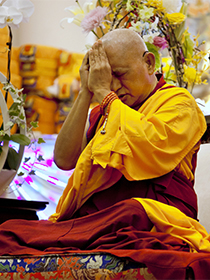- Home
- FPMT Homepage
Foundation for the Preservation of the Mahayana Tradition
The FPMT is an organization devoted to preserving and spreading Mahayana Buddhism worldwide by creating opportunities to listen, reflect, meditate, practice and actualize the unmistaken teachings of the Buddha and based on that experience spreading the Dharma to sentient beings. We provide integrated education through which people’s minds and hearts can be transformed into their highest potential for the benefit of others, inspired by an attitude of universal responsibility and service. We are committed to creating harmonious environments and helping all beings develop their full potential of infinite wisdom and compassion. Our organization is based on the Buddhist tradition of Lama Tsongkhapa of Tibet as taught to us by our founders Lama Thubten Yeshe and Lama Thubten Zopa Rinpoche.
- Willkommen
Die Stiftung zur Erhaltung der Mahayana Tradition (FPMT) ist eine Organisation, die sich weltweit für die Erhaltung und Verbreitung des Mahayana-Buddhismus einsetzt, indem sie Möglichkeiten schafft, den makellosen Lehren des Buddha zuzuhören, über sie zur reflektieren und zu meditieren und auf der Grundlage dieser Erfahrung das Dharma unter den Lebewesen zu verbreiten.
Wir bieten integrierte Schulungswege an, durch denen der Geist und das Herz der Menschen in ihr höchstes Potential verwandelt werden zum Wohl der anderen – inspiriert durch eine Haltung der universellen Verantwortung und dem Wunsch zu dienen. Wir haben uns verpflichtet, harmonische Umgebungen zu schaffen und allen Wesen zu helfen, ihr volles Potenzial unendlicher Weisheit und grenzenlosen Mitgefühls zu verwirklichen.
Unsere Organisation basiert auf der buddhistischen Tradition von Lama Tsongkhapa von Tibet, so wie sie uns von unseren Gründern Lama Thubten Yeshe und Lama Thubten Zopa Rinpoche gelehrt wird.
- Bienvenidos
La Fundación para la preservación de la tradición Mahayana (FPMT) es una organización que se dedica a preservar y difundir el budismo Mahayana en todo el mundo, creando oportunidades para escuchar, reflexionar, meditar, practicar y actualizar las enseñanzas inconfundibles de Buda y en base a esa experiencia difundir el Dharma a los seres.
Proporcionamos una educación integrada a través de la cual las mentes y los corazones de las personas se pueden transformar en su mayor potencial para el beneficio de los demás, inspirados por una actitud de responsabilidad y servicio universales. Estamos comprometidos a crear ambientes armoniosos y ayudar a todos los seres a desarrollar todo su potencial de infinita sabiduría y compasión.
Nuestra organización se basa en la tradición budista de Lama Tsongkhapa del Tíbet como nos lo enseñaron nuestros fundadores Lama Thubten Yeshe y Lama Zopa Rinpoche.
A continuación puede ver una lista de los centros y sus páginas web en su lengua preferida.
- Bienvenue
L’organisation de la FPMT a pour vocation la préservation et la diffusion du bouddhisme du mahayana dans le monde entier. Elle offre l’opportunité d’écouter, de réfléchir, de méditer, de pratiquer et de réaliser les enseignements excellents du Bouddha, pour ensuite transmettre le Dharma à tous les êtres. Nous proposons une formation intégrée grâce à laquelle le cœur et l’esprit de chacun peuvent accomplir leur potentiel le plus élevé pour le bien d’autrui, inspirés par le sens du service et une responsabilité universelle. Nous nous engageons à créer un environnement harmonieux et à aider tous les êtres à épanouir leur potentiel illimité de compassion et de sagesse. Notre organisation s’appuie sur la tradition guéloukpa de Lama Tsongkhapa du Tibet, telle qu’elle a été enseignée par nos fondateurs Lama Thoubtèn Yéshé et Lama Zopa Rinpoché.
Visitez le site de notre Editions Mahayana pour les traductions, conseils et nouvelles du Bureau international en français.
Voici une liste de centres et de leurs sites dans votre langue préférée
- Benvenuto
L’FPMT è un organizzazione il cui scopo è preservare e diffondere il Buddhismo Mahayana nel mondo, creando occasioni di ascolto, riflessione, meditazione e pratica dei perfetti insegnamenti del Buddha, al fine di attualizzare e diffondere il Dharma fra tutti gli esseri senzienti.
Offriamo un’educazione integrata, che può trasformare la mente e i cuori delle persone nel loro massimo potenziale, per il beneficio di tutti gli esseri, ispirati da un’attitudine di responsabilità universale e di servizio.
Il nostro obiettivo è quello di creare contesti armoniosi e aiutare tutti gli esseri a sviluppare in modo completo le proprie potenzialità di infinita saggezza e compassione.
La nostra organizzazione si basa sulla tradizione buddhista di Lama Tsongkhapa del Tibet, così come ci è stata insegnata dai nostri fondatori Lama Thubten Yeshe e Lama Zopa Rinpoche.
Di seguito potete trovare un elenco dei centri e dei loro siti nella lingua da voi prescelta.
- 欢迎 / 歡迎
简体中文
“护持大乘法脉基金会”( 英文简称:FPMT。全名:Foundation for the Preservation of the Mahayana Tradition) 是一个致力于护持和弘扬大乘佛法的国际佛教组织。我们提供听闻,思维,禅修,修行和实证佛陀无误教法的机会,以便让一切众生都能够享受佛法的指引和滋润。
我们全力创造和谐融洽的环境, 为人们提供解行并重的完整佛法教育,以便启发内在的环宇悲心及责任心,并开发内心所蕴藏的巨大潜能 — 无限的智慧与悲心 — 以便利益和服务一切有情。
FPMT的创办人是图腾耶喜喇嘛和喇嘛梭巴仁波切。我们所修习的是由两位上师所教导的,西藏喀巴大师的佛法传承。
繁體中文
護持大乘法脈基金會”( 英文簡稱:FPMT。全名:Found
ation for the Preservation of the Mahayana Tradition ) 是一個致力於護持和弘揚大乘佛法的國際佛教組織。我們提供聽聞, 思維,禪修,修行和實證佛陀無誤教法的機會,以便讓一切眾生都能 夠享受佛法的指引和滋潤。 我們全力創造和諧融洽的環境,
為人們提供解行並重的完整佛法教育,以便啟發內在的環宇悲心及責 任心,並開發內心所蘊藏的巨大潛能 — 無限的智慧與悲心 – – 以便利益和服務一切有情。 FPMT的創辦人是圖騰耶喜喇嘛和喇嘛梭巴仁波切。
我們所修習的是由兩位上師所教導的,西藏喀巴大師的佛法傳承。 察看道场信息:
- FPMT Homepage
- News/Media
-
- Study & Practice
-
-
- About FPMT Education Services
- Latest News
- Programs
- New to Buddhism?
- Buddhist Mind Science: Activating Your Potential
- Heart Advice for Death and Dying
- Discovering Buddhism
- Living in the Path
- Exploring Buddhism
- FPMT Basic Program
- FPMT Masters Program
- FPMT In-Depth Meditation Training
- Maitripa College
- Lotsawa Rinchen Zangpo Translator Program
- Universal Education for Compassion & Wisdom
- Online Learning Center
-
- Prayers & Practice Materials
- Overview of Prayers & Practices
- Full Catalogue of Prayers & Practice Materials
- Explore Popular Topics
- Benefiting Animals
- Chenrezig Resources
- Death & Dying Resources
- Lama Chopa (Guru Puja)
- Lama Zopa Rinpoche: Compendium of Precious Instructions
- Lama Zopa Rinpoche: Life Practice Advice
- Lama Zopa Rinpoche Practice Series
- Lamrim Resources
- Mantras
- Prayer Book Updates
- Purification Practices
- Sutras
- Thought Transformation (Lojong)
- Audio Materials
- Dharma Dates - Tibetan Calendar
- Translation Services
- Publishing Services
- Ways to Offer Support
- Prayers & Practice Materials
-
- Teachings and Advice
- Find Teachings and Advice
- Lama Zopa Rinpoche Advice Page
- Lama Zopa Rinpoche: Compendium of Precious Instructions
- Lama Zopa Rinpoche Video Teachings
- ༧སྐྱབས་རྗེ་བཟོད་པ་རིན་པོ་ཆེ་མཆོག་ནས་སྩལ་བའི་བཀའ་སློབ་བརྙན་འཕྲིན།
- Podcasts
- Lama Yeshe Wisdom Archive
- Buddhism FAQ
- Dharma for Young People
- Resources on Holy Objects
- Teachings and Advice
-
-
*If a menu item has a submenu clicking once will expand the menu clicking twice will open the page.
-
-
- Centers
-
- Teachers
-
- Projects
-
-
-
-
*If a menu item has a submenu clicking once will expand the menu clicking twice will open the page.
-
-
- FPMT
-
-
-
-
-
We can transform any problem, even death, into happiness. The point is not to stop the experience of problems but to stop the conditions that we call ‘problems’ from disturbing our mind, and instead use them to support the spiritual path that we practice.
Lama Zopa Rinpoche
-
-
-
- Shop
-
-
-
The Foundation Store is FPMT’s online shop and features a vast selection of Buddhist study and practice materials written or recommended by our lineage gurus. These items include homestudy programs, prayers and practices in PDF or eBook format, materials for children, and other resources to support practitioners.
Items displayed in the shop are made available for Dharma practice and educational purposes, and never for the purpose of profiting from their sale. Please read FPMT Foundation Store Policy Regarding Dharma Items for more information.
-
-
FPMT News Around the World
4
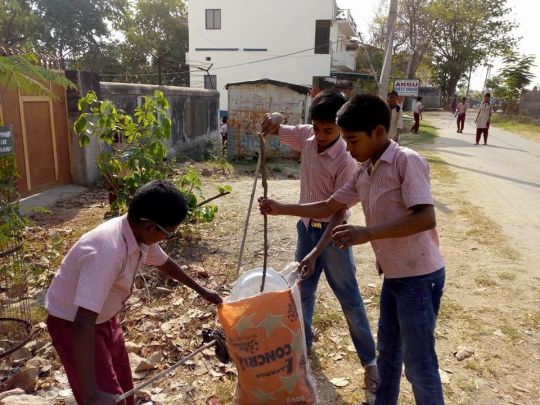
Maitreya School children collecting trash from the roadside outside of their school grounds, Maitreya School, Bodhgaya, India, April 2018. Photo by Pema Tsering.
Anrich Bester, a volunteer at Maitreya School in Bodhgaya, India, shares stories about the students’ involvement with the Bodhgaya Clean Environment Hygiene and Sanitation Program. Maitreya School, a social project of Root Institute for Wisdom Culture (Root Institute), collaborated with Karuna-Shenchen on this project on several occasions.
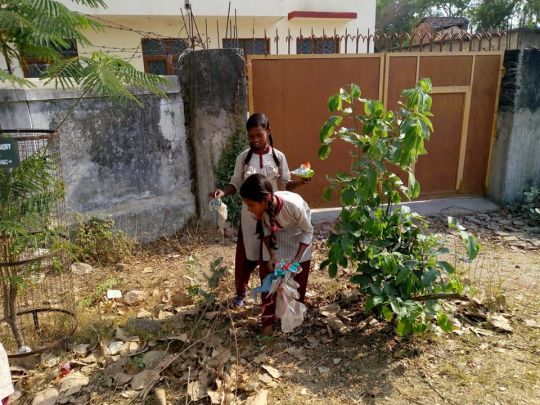
Maitreya School children collecting trash from the roadside outside of their school grounds, Maitreya School, Bodhgaya, India, April 2018. Photo by Pema Tsering.
One of Root Institute’s previous volunteers, Eric Foucart, together with some friends, including a nonprofit operating in Bodhgaya, Karuna-Shechen, as well as Root Institute’s grounds manager, Gabriel Forrer, helped us to organize workshops on waste management and recycling, and obtain the required equipment to clean Bodhgaya’s streets effectively and efficiently.
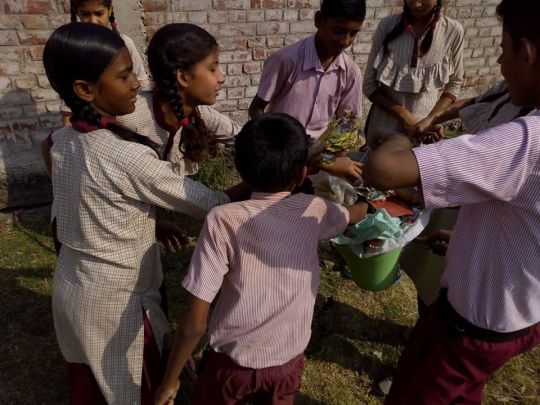
Maitreya School children collecting trash from the roadside outside of their school grounds, Maitreya School, Bodhgaya, India, April 2018. Photo by Pema Tsering.
Not only did we clean the streets and our surroundings, but we created awareness and educated the local community members on how to dispose of their garbage in an environmentally-friendly way. It was not easy to convince people to change their behavior patterns, but we hope that the seeds we planted within the local community members will grow, in order to create a better, cleaner environment.
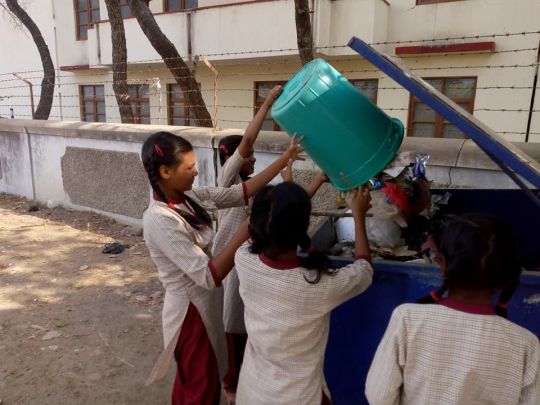
Maitreya School children emptying their collected trash into a dumpster, Maitreya School, Bodhgaya, India, April 2018. Photo by Pema Tsering.
Pema Tsering, principal at Maitreya School explains the effect the waste management and recycling project had on the students, too.
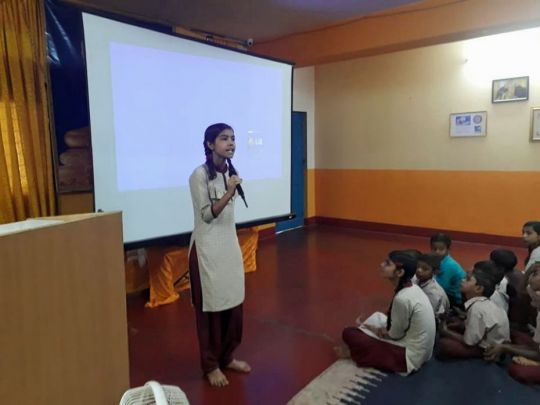
Maitreya School student presenting to the school, Maitreya School, Bodhgaya, India, May 2018. Photo by Pema Tsering.
On a regular basis, Maitreya School students share their good thoughts and knowledge with their fellow students in the morning assembly. Children Teaching Children is a beautiful program we started in our school, where everyone learns everything from everyone else. This is the stage at which children build their confidence, plan projects, learn from their mistakes, learn to face challenges, expand their creativity, and accumulate knowledge.
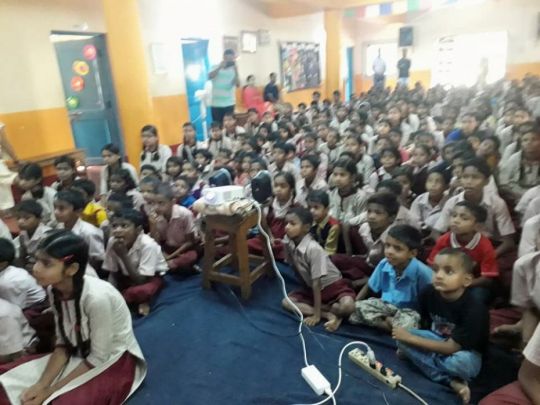
Maitreya School students watching a video about Maitreya School’s Community Service Project in the auditorium of their school, Maitreya School, Bodhgaya, India, May 2018. Photo by Pema Tsering.
One morning in April our senior students shared their experiences regarding the cleanliness project. They gave a presentation on the importance of cleanliness in our daily lives, and the students watched a video about the project made by Eric Foucart.
A great “thank you” to Eric for making this special video about our school and our waste management project. We truly appreciate your time and energy.
Watch Maitreya Community Service Project by Eric Foucart and narrated by the children on YouTube:
https://youtu.be/_fZVUo700q4
For more information about Maitreya School visit the Root Institute’s website:
https://www.rootinstitute.ngo/social-service/maitreya-school
You can view Maitreya School’s Wish List on the Amazon India website:
https://www.amazon.in/registry/wishlist/182QRM38BA9R5/ref=cm_sw_r_cp_ep_ws_T3R3Ab1VD28N0
FPMT.org and Mandala Publications brings you news of Lama Zopa Rinpoche and of activities, teachings, and events from over 160 FPMT centers, projects, and services around the globe. If you like what you read, consider becoming a Friend of FPMT, which supports our work.
- Tagged: anrich bester, environment, maitreya school, pema tsering, root institute, video, video short
27

Guests watching a fireworks and animated light show at ILLUMIN8, The Great Stupa of Universal Compassion, Bendigo, Australia, May 2018. Photo by The Great Stupa team.
ILLUMIN8 is an annual event held at the Great Stupa of Universal Compassion in Bendigo, Australia, celebrating peace and harmony inspired by Buddha’s life story. This year ILLUMIN8 also celebrated the return of the Jade Buddha for Universal Peace to its home inside of The Great Stupa. The statue was consecrated on May 17 and unveiled to the public on May 18, May 19, and May 20, 2018, during ILLUMIN8. The Great Stupa team shared this update:
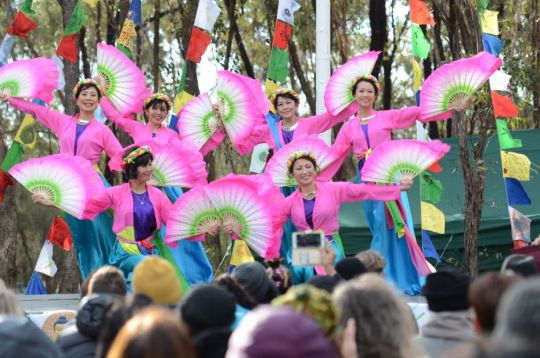
Âu Co Dance Group performing Âm Vang Hạnh Phúc at ILLUMIN8, Great Stupa of Universal Compassion, Bendigo, Australia, May 2018. Photo by The Great Stupa team.
In May we celebrated Vesak, a day commemorating Buddha’s birth, enlightenment, and death, with our very own ILLUMIN8: Festival of Light and Peace with 10,000 guests. The feedback we’ve received after the event has been overwhelmingly positive with many visitors calling in and reviewing or commenting on our social media channels.
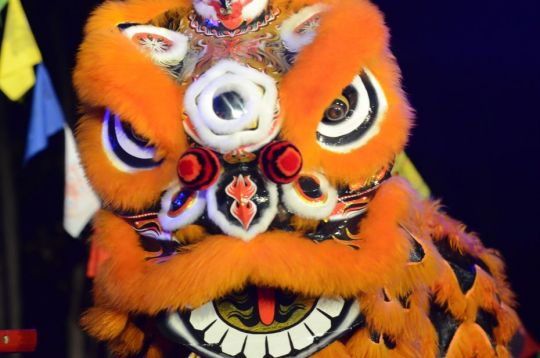
A dragon at ILLUMIN8 organized by the Bendigo Chinese Association, Great Stupa of Universal Compassion, Bendigo, Australia, May 2018. Photo by The Great Stupa team.
We’re so proud of and thankful to our staff and volunteer teams who helped make this year truly special. Welcoming home the Jade Buddha for Universal Peace also made 2018 a year to remember!
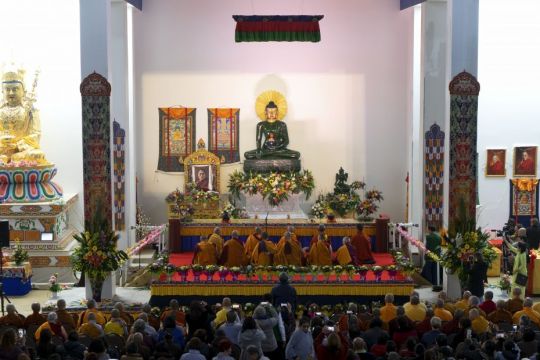
Monks from Thubten Shedrup Ling Monastery and ILLUMIN8 guests with the Jade Buddha for Universal Peace, Great Stupa of Universal Compassion, Bendigo, Australia, May 2018. Photo by the Great Stupa team.
We wanted to share with you some of our favorite photos and a video from the event. We hope they give people that couldn’t make it a feeling of being there, and for the people that did attend a reminder of how wonderful a time they had.

Youth from Scott’s Mascots and Costumes Academy at ILLUMIN8, Great Stupa of Universal Compassion, Bendigo, Australia, May 2018. Photo by the Great Stupa team.
A lovely recap video that was produced by the Victoria, Australia State Government’s Department of Economic Development, Jobs, Transport and Resources for publication by Victorian Connection.
Watch the ILLUMIN8 recap video on YouTube:
https://youtu.be/qeTNjiWEh7Q
To learn more about the Great Stupa of Universal Compassion, the Jade Buddha for Universal Peace, and ILLUMIN8 2019 visit the website:
https://www.stupa.org.au
Watch more videos from the Great Stupa of Universal Compassion on the Great Stupa’s YouTube channel:
https://www.youtube.com/channel/UCHD5AnLFoixyKFYhFU2mrlw/featured
To hear the history of the Jade Buddha listen to the Australian Broadcasting Corporation (ABC) radio interview with Ian Green, director of The Great Stupa of Universal Compassion:
http://www.abc.net.au/radio/sydney/programs/nightlife/this-mortal-coil-ian-green/9830002
Lama Zopa Rinpoche is the spiritual director of the Foundation for the Preservation of Mahayana Tradition (FPMT), a Tibetan Buddhist organization dedicated to the transmission of the Mahayana Buddhist tradition and values worldwide through teaching, meditation, and community service.
20

Youth participants in the 16 Guidelines English language classes, Ulaanbaatar, Mongolia, January 2018. Photo by Altangerel Tumurtogoo.
FPMT center Ganden Do Ngag Shedrup Ling has begun offering children’s classes on the 16 Guidelines for Life, an initiative of the Foundation for Developing Compassion and Wisdom (FDCW). These classes are taught to the children in the English language so the youth can learn English while also learning how to live a happy life.
Ganden Do Ngag Shedrup Ling’s center director Ianzhina Bartanova shared the inspiration behind this initiative, the first of its kind in Mongolia:
Since the early 2000s it has been one of Lama Zopa Rinpoche’s visions for Mongolia that we commence teaching the English language with a Dharma focus. In May 2017, while Lama Zopa Rinpoche was visiting Mongolia, Rinpoche advised that it would be very good for us to continue offering English language classes, and to utilize the 16 Guidelines for Life for the curriculum.
Our first initiative was to develop the program for children, based on the lesson plans contained in the kit Ready, Set, Happy. Published by FPMT international project FDCW, Ready, Set, Happy is a collection of songs, poems, plays, games, and scientific experiments adults can use to present the 16 Guidelines to children ages seven to eleven.
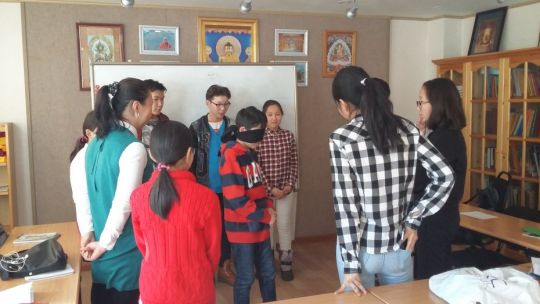
Youth participating in the 16 Guidelines English language classes, Ulaanbaatar, Mongolia, January 2018. Photo by Ianzhina Bartanova.
With great help and support from FDCW and Denise Flora who has participated in FDCW’s The a.r.t. of Fulfillment course, we were able to prepare our curriculum.
We chose to initiate the 16 Guidelines English language program with children because by sharing the knowledge and skills gained through the program with their families and friends, the children can bring compassion, wisdom, and universal responsibility to their families. We have the intention to gradually adapt the program for adults and in this way effect positive changes in more Mongolian families.
Also with the English language being a most convenient and popular language in the world, we see that this learning will open many more doors for the participants and their futures as so many Dharma materials and teachings are available in English.
Our sincere aspiration for this project is to support the development and growth of universal children, who will be able to spread the values of love, compassion, justice, forgiveness, mindfulness, tolerance, and peace throughout the world.
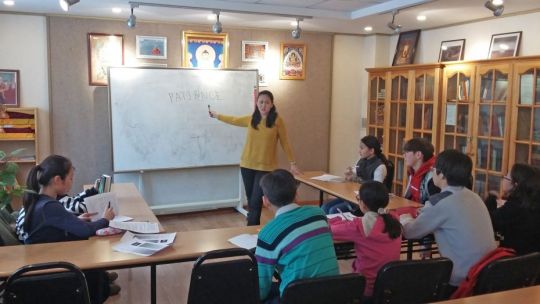
Ganden Do Ngag Shedrup Ling’s 16 Guidelines teacher Altangerel Tumurtogoo and students, Ulaanbaatar, Mongolia, January 2018. Photo by Ianzhina Bartanova.
Ganden Do Ngag Shedrup Ling’s 16 Guidelines teacher Altangerel Tumurtogoo shared stories from the children’s classes:
There are ten children, ages ten to fifteen in our 16 Guidelines classes. At the beginning the children were very shy. I had noticed in other previous classes that shyness and humility are the biggest barriers for Mongolian children. Besides shyness, speaking in English was the second problem for the children.
The children steadily began to express their opinions in class. This started to happen after we read some stories, something we do in every class. When the story finished the children had the opportunity to exchange thoughts, explore ways of working together, and express their ideas as a group.
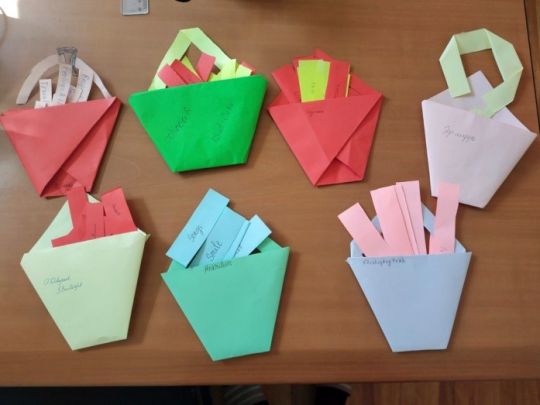
Buckets made by students in class, Ulaanbaatar, Mongolia, January 2018. Photo by Altangerel Tumurtogoo.
When we read the story Have You Filled a Bucket Today?: A Guide to Daily Happiness for Kids by Carol McCloud, one of our children said, “The bucket represents people’s minds. When we are happy and satisfied, our mind is peaceful. When our mind is peaceful, we can make us as well as others happy like filling a bucket. But when we are sad and dissatisfied, we make us and others unhappy like dipping a bucket.” Of course after reading this story together we all just want to be the bucket filler.
We also drew pictures and made our own buckets, filling them with the words that we want to have, and did a wonderful rainbow according to the stories.
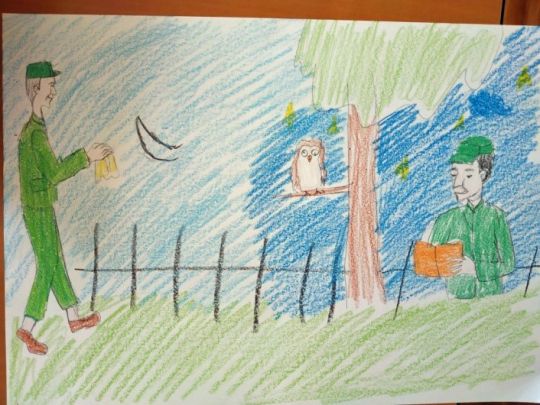
Student artwork made in class, Ulaanbaatar, Mongolia, January 2018. Photo by Altangerel Tumurtogoo.
As a tradition, we play active games at the beginning of each class to motivate ourselves and have fun. At the end of every class we play games to practice our English such as broken phone, word guessing, and puzzles.

Students playing games together and practicing their English, Ulaanbaatar, Mongolia, January 2018. Photo by Altangerel Tumurtogoo.
The children shared some stories about the importance of humility, patience, contentment, delight, generosity, and honesty from their lives. We discussed the disadvantages of being proud, greedy, and telling lies, and how we could behave the opposite way. Surprisingly, we needed almost six months before we were able to become open-minded and treat each other as one team.
I find it beautiful that the children now have the power to make good behavior decisions and act with kindness in society. We are trying to increase the number of this kind of people in our society.
For more information about Ganden Do Ngag Shedrup Ling visit their website:
http://www.fpmtmongolia.org/shedrub-ling-center/
To learn more about the Foundation for Developing Compassion and Wisdom and the 16 Guidelines for Life visit the FDCW website:
https://www.compassionandwisdom.org
A hard copy of The Sixteen Guidelines for Life is available through the FPMT Foundation Store:
https://shop.fpmt.org/The-16-Guidelines-for-Life_p_816.html
FPMT.org and Mandala Publications brings you news of Lama Zopa Rinpoche and of activities, teachings, and events from over 160 FPMT centers, projects, and services around the globe. If you like what you read, consider becoming a Friend of FPMT, which supports our work.
- Tagged: 16 guidelines, Altangerel Tumurtogoo, foundation for developing compassion and wisdom, ganden do ngag shedrup ling, ianzhina bartanova
13
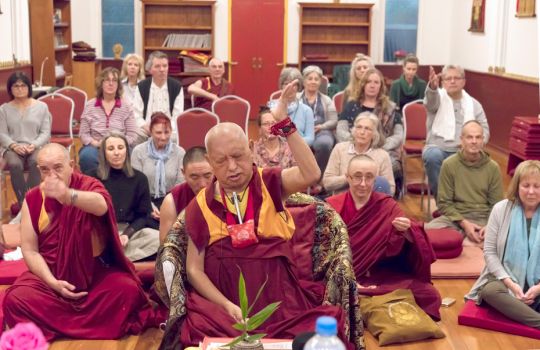
Lama Zopa Rinpoche consecrating the center’s new building, Buddha House, South Australia, May 2018. Photo by Ven. Lobsang Sherab.
FPMT center Buddha House, located in a suburb of Adelaide, South Australia, recently received a visit from Lama Zopa Rinpoche who blessed the center’s new home. The Buddha House community shares the story with us:
During the Bodhicaryavatara (A Guide to the Bodhisattva’s Way of Life) and Rinjung Gyatsa Retreat at The Great Stupa of Universal Compassion in Bendigo, Australia, in 2014, Buddha House resident teacher Ven. Thubten Dondrub, the then-director Gabe Edwards, and members of Buddha House had a meeting with Rinpoche.
Leading up to that meeting Buddha House was going through a period of instability. Only a few months earlier, we had lost our director, spiritual program coordinator, and treasurer due to ill health and all within a few weeks of each other. We were up against many challenges, including low morale and financial hardship, placing a lot of added pressure to keep the center running harmoniously. There were many obstacles to overcome during this period, making it one of the most difficult in the thirty-seven year history of Buddha House.
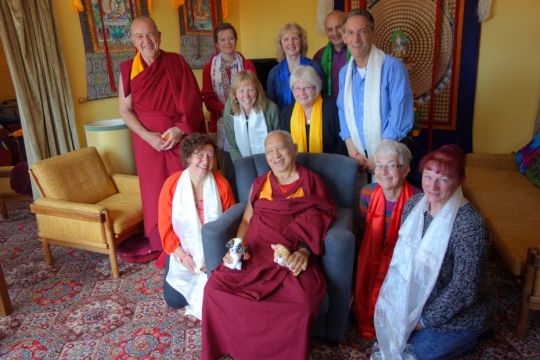
Katrin Rheder, Gabe Edwards, Tony Migalka, Ven. Thubten Dondrub, Lyndy Abram, Judy Wagner, Bill Gaston, Cristina Gonzalez, Jan Vaughan, and Sheryl Malone with Lama Zopa Rinpoche, The Great Stupa, Bendigo, Australia, 2014. Photo by Ven. Roger Kunsang.
We were leasing space in a premises owned by the Freemasons, which greatly impacted our ability to expand the program as we would have liked. Competing with dance classes, hall hire for parties, celebrations, and regular evening meetings of Freemasons, it was very difficult to keep students motivated and the future looked unclear.
So during the 2014 retreat, Gabe requested an audience with Rinpoche, enabling students to come together as a group to talk with him.
As a result of that meeting, Rinpoche’s advice for the center to flourish and to promote harmony was to practice the Sixteen Arhats Puja regularly, and in addition, Rinpoche advised us to commission a large Ganapati statue.
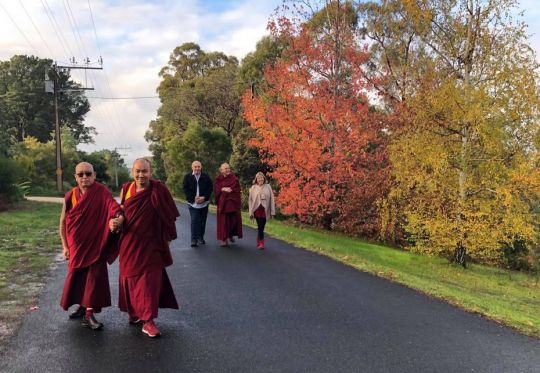
Lama Zopa Rinpoche, Ven. Thubten Tendar, Buddha House former director Tony Migalka, Buddha House resident teacher Ven. Thubten Dondrub, and Buddha House current director Lyndy Abram enjoying the autumn leaves in the beautiful Adelaide hills, South Australia, May 2018. Photo by Carole Migalka.
The Buddha House Board and students under the guidance of Ven. Thubten Dondrub promptly followed the Guru’s advice. Soon after and due to the kindness of a benefactor, the Sixteen Arhat statues were acquired. They arrived by ship from Nalanda Monastery in France in 2015. The Sixteen Arhat statues were exquisitely painted by Tibetan artist Ven. Lobsang Konchok and are now part of the main altar at Buddha House. Many thanks to Ven. Lobsang, who also painted the mural of the Dharmachakra surrounded by eight offering dakinis inside of The Great Stupa.
After 3 years of construction by artist Jonathan Partridge in Tasmania, the large Ganapati statue was installed at the center in early May 2018, just days before Rinpoche’s arrival.
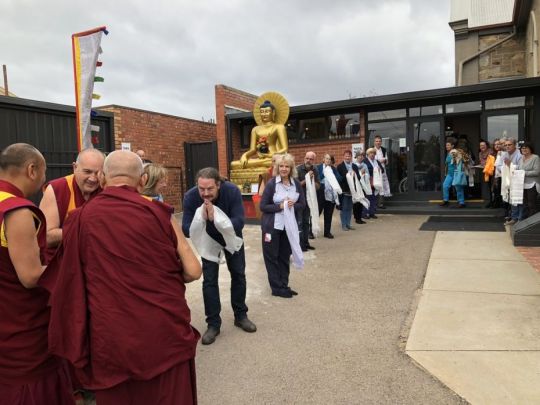
Lama Zopa Rinpoche arriving at Buddha House, South Australia, May 17, 2018. Photo by Ven. Roger Kunsang.
In late January 2016 a Buddha House student saw a property for auction, which was a beautiful and spacious blue-stone church in a perfect location.
Rinpoche’s observation showed that it was beneficial to purchase the property. He recommended various practices for our success, including the making of one thousand Ganapati tsa-tsas. Buddha House had just nine days before the auction to complete Rinpoche’s advice, and with the help of many, including Chenrezig Institute with the making of the tsa-tsas, Budda House fulfilled his instructions within the required time. We made a successful bid for the property in February 2016, and after many months of renovations, Buddha House moved in to their new home in January 2017.
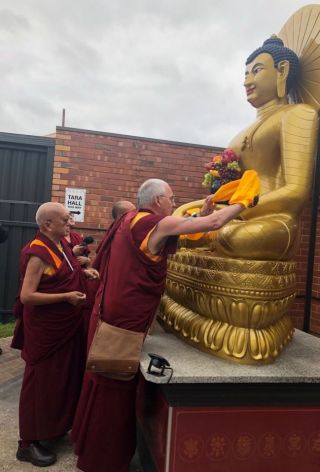
Lama Zopa Rinpoche, Ven. Roger Kunsang, Ven. Thubten Tendar, and Ven. Lobsang Sherab offering a khata to the new Buddha statue at Buddha House, South Australia, May 2018. Photo by Carole Migalka.
Following the Guru’s advice when many obstacles and financial demands are being experienced can take courage. However, the Board of Buddha House found that when demonstrating faith in following our precious teacher’s advice unerringly, incredible things happen. After commissioning the Ganapati Statue, practicing the Sixteen Arhats Puja regularly, and then acquiring the Sixteen Arhats statues, a very generous benefactor made available the funds that enabled us to purchase our new property.
Rinpoche entered our new center building for the first time on Thursday, May 17, 2018. On that day he had a tour of the center while meeting members of the Buddha House Board, office volunteers, meditation leaders, and those who help out with the teaching program. In the gompa in front of about thirty people, including Ven. Roger Kunsang, Ven. Thubten Dondrub, Ven. Lobsang Konchok, Ven. Lobsang Sherab, Ven. Thubten Tendar, and Ven. Tenzin Lhamo, Rinpoche consecrated the Sixteen Arhat statues.
After months of preparation at Buddha House, Lama Zopa Rinpoche officially opened our new center on Sunday, May 20, and what a wonderfully joyous, moving and colorful multicultural day it was! About two hundred people attended, including members of parliament and local government, as well as representatives from multi-faith organizations. The official ceremony began in Tara Hall with the moving Welcome to Country ceremony conducted by “Uncle Moogy” Sumner, who called his ancestors as well as ours in his native language, and gave us his blessing as a tribal custodian to conduct our center’s work and program without negative obstructions.
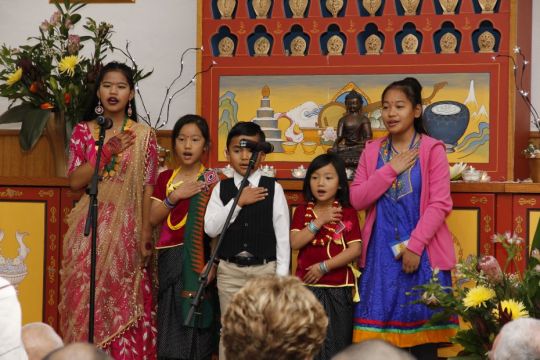
The Himalayan and Tibetan Children’s Choir performing at Buddha House, South Australia, May 2018, Photo by Hugh Sparrow.
Lama Zopa Rinpoche then unveiled the Heart Sutra plaque while chanting, and with the ordained Sangha joining in, blessed the center. Rinpoche spoke of how much benefit the center would be to so many sentient beings for many years to come. The plaque has since been mounted by the entrance to Buddha House, giving all those who enter opportunity to read this extremely powerful sutra.
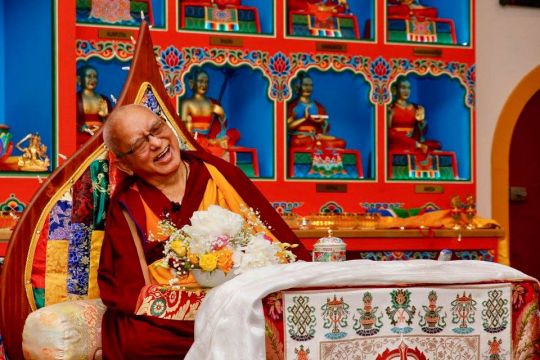
Lama Zopa Rinpoche sharing laughs with students at Buddha House, South Australia, May 2018. Photo by Carole Migalka.
After a sumptuous afternoon tea, Rinpoche gave a very special talk in the gompa on how to make the most of our life. He advised us to study the lamrim, meditate on the lamrim, and actualize the lamrim, develop guru devotion, and live our lives with bodhichitta as much as possible.
It was heart-warming to see the past directors, members and friends of Buddha House, as well as families from the Himalayan Buddhist Society of South Australia and the Tibetan Society of South Australia. There was dancing by women in national costume and a children’s choir by our Himalayan and Tibetan friends. Many thanks to the Himalayan Buddhist Community for making the chai tea, and the Buddha House community for an abundance of delicious sweet and savory food.
Members, students, and volunteers of Buddha House worked tirelessly and harmoniously together over several months to bring the event together—from cleaners, car parking attendants, to the gompa setup team, kitchen catering, flower arrangers, and hosts for the day. It was only due to the kindness all of these volunteers that the afternoon was such a great success.
In our new location the program has been expanded to allow for day and evening meditations, teachings, and children’s programs. Tara Hall is available for yoga, tai chi, and reiki. The center has become very valuable in the community with people coming and going all day attending programs, popping in to get information regarding programs, and also attracting people into the gompa for their own personal meditation.
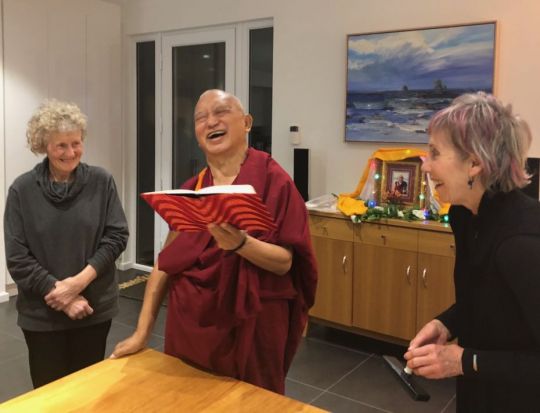
Natalie Playford and Judy McDonald who cooked for Lama Zopa Rinpoche sharing a moment with Rinpoche as he had them print mantras in a book to see who had the most merit to print the perfect mantra, Buddha House, South Australia, May 2018. Photo by Carole Migalka.
What we now have is the culmination of many years of concerted effort by a succession of center directors and board members, securing a stable, beautiful, spacious, and functional center that will serve our community for many years to come.
The final success came from asking our Guru for specific advice, and collectively following this to the letter. As a result everything has flowed seamlessly and incredible abundance has followed. Please join us in rejoicing.
For more information about Buddha House visit their website:
http://buddhahouse.org
FPMT.org and Mandala Publications brings you news of Lama Zopa Rinpoche and of activities, teachings, and events from over 160 FPMT centers, projects, and services around the globe. If you like what you read, consider becoming a Friend of FPMT, which supports our work.
6
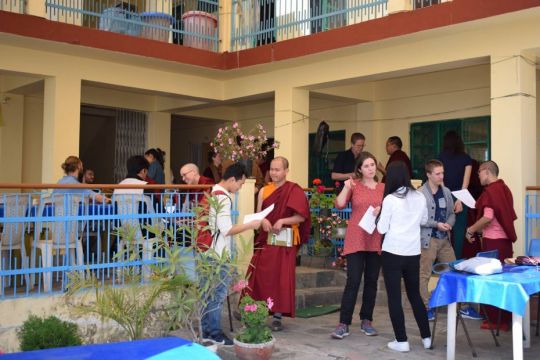
LRZTP8 begins, Dharamsala, India, March 2018. Photo courtesy of Lotsawa Rinchen Zangpo Translator Program’s Facebook page.
Yaron Bahir, director of FPMT project Lotsawa Rinchen Zangpo Translator Program in Dharamsala, India, shares his excitement about the newest cohort of Tibetan language translation students:
March 16, 2018, was a special day for us in the Lotsawa Rinchen Zangpo Translator Program. We conducted the opening ceremony of the eighth two-year course, known as LRZTP8.

Geshe Tenzin Wangdak and Yaron Bahir welcoming new student Mark to LRZTP8, Dharamsala, India, March 2018. Photo courtesy of Lotsawa Rinchen Zangpo Translator Program’s Facebook page.
We now have thirteen zealous students in LRZTP8 from all around the world.
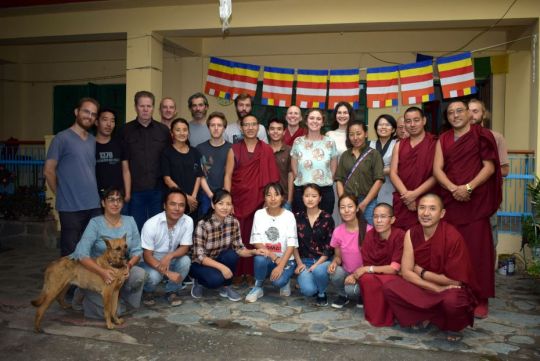
LRZTP8 teachers and conversation tutors together with the students and Gen Christabella, Dharamsala, India, June 2018. Photo courtesy of Lotsawa Rinchen Zangpo Translator Program.
We welcome one student each from Taiwan, Vietnam, Germany, Russia, Spain, Mexico, Israel, France, and Poland. We also welcome two students who are joining us from the United States and two students who are joining us from Australia.
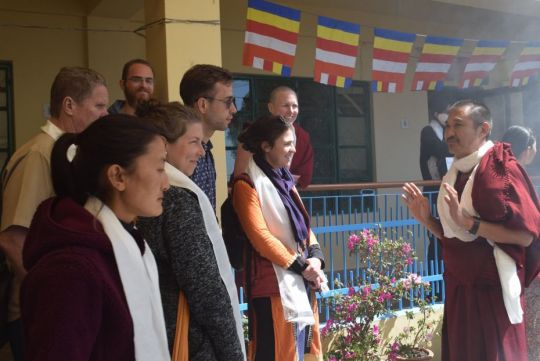
Geshe Tenzin Wangdak with LRZTP8 students, Dharamsala, India, March 2018. Photo courtesy of Lotsawa Rinchen Zangpo Translator Program’s Facebook page.
They will study Tibetan for two years and then some of them will enter the intensive interpreting training program.
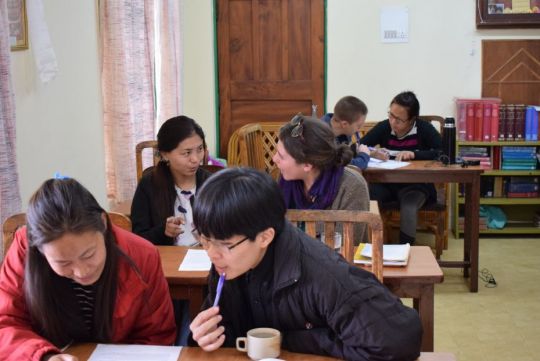
LRZTP8 students and conversation partners inside of a LRZTP classroom, Dharamsala, India, March 2018. Photo by Alex García.
We would also like to welcome new teachers Filip Majkowski and Alex García who have joined our staff.
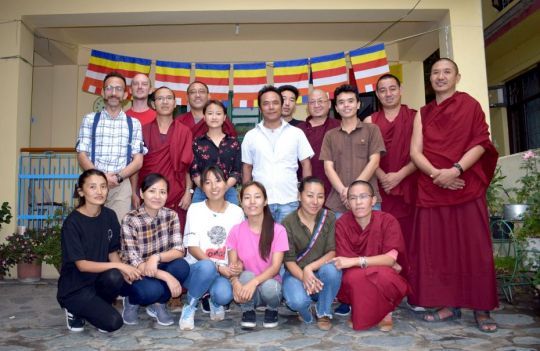
LRZTP8 teachers and conversation tutors, Dharamsala, India, June 2018. Photo courtesy of Lotsawa Rinchen Zangpo Translator Program.
Filip Majkowski will serve as the main teacher together with our long-time beloved teacher Geshe Tenzin Wangdak. Filip Majkowski is also our local director. Another new teacher is Alex García, graduate of LRZTP7. He will be assisting the main teachers.
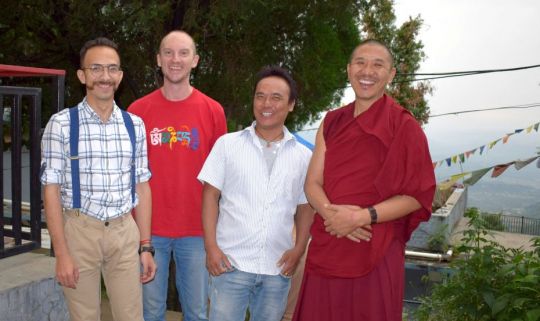
Alex García, Filip Majkowski, Thubten-la, and Geshe Tenzin Wangdak, Dharamsala, India, June 2018. Photo courtesy of Lotsawa Rinchen Zangpo Translator Program.
Also in the summer, from July 2 to August 24, 2018, we will have an intensive eight-week summer course with Julia Wilson here in Dharamsala, India. This Tibetan course will be for beginners. Students will learn how to read Tibetan, speak basic colloquial conversations, understand basic literary grammar, and learn common Dharma terms that are used in texts and teachings. You are welcome to join. There is a reduced price for Indian citizens. You can check details on our website.
For more information about the Lotsawa Rinchen Zangpo Translator Program in Dharamsala, India visit their website:
http://www.lrztp.org
FPMT.org and Mandala Publications brings you news of Lama Zopa Rinpoche and of activities, teachings, and events from over 160 FPMT centers, projects, and services around the globe. If you like what you read, consider becoming a Friend of FPMT, which supports our work.
30
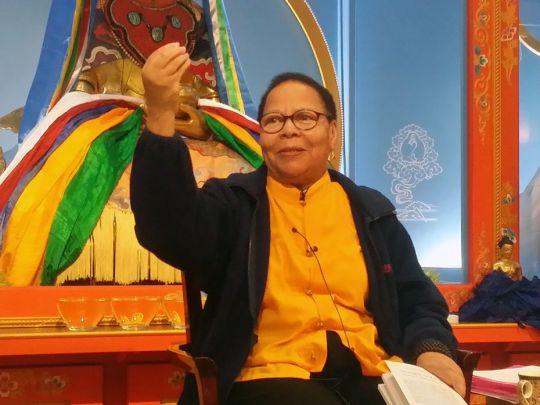
Dr. Jan Willis brings vigor into her teachings, Maitripa College, Portland, Oregon, US, October 2017. Photo courtesy of Leigh Miller.
Last Fall, Jan Willis, PhD, offered a three-week course, “Making the Invisible, Visible: The Other Side of ‘Perfect’: A Multi-media and Interactive Exploration of Race and Racism in the US,” as well as a public talk at Maitripa College in Portland, Oregon, US. Jan was an early student of Lama Yeshe and went on to become a well respected Buddhist studies scholar and teacher in the United States.
Namdrol Miranda Adams, Maitripa College Dean of Education and Community Service Instructor, shares key messages from the course taught at the Buddhist college. Namdrol’s story was originally published in the Winter 2017 issue of Northwest Dharma News:
Division by race continues to be an issue in the evolution of the Dharma in the West, leading a noted scholar and Dharma teacher to take on the subject for a course this recent autumn.
The course, at Maitripa College in Portland, was called: “Making the Invisible, Visible: The Other Side of ‘Perfect’: A Multi-media and Interactive Exploration of Race and Racism in the U.S.”
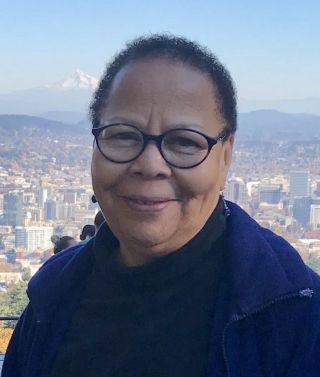
Dr. Jan Willis. Photo courtesy of Maitripa College.
It was led by Dr. Jan Willis, a noted Buddhist studies scholar, professor emerita of religion at Wesleyan University, and visiting professor at Agnes Scott College in Decatur, Georgia. Willis has been a student of Tibetan Buddhism for over forty years, and is a longtime friend to Maitripa.
The intention of the course was, in the safety and sanctity of a Buddhist environment, to explore the deep and troubling issues of race and racism in our country and in our lives. The course explored such questions as: “How does Buddhism help us to recognize our biases?” and “How does it provide meaningful solutions?”
Course objectives included giving students foundational knowledge in basic, relevant Buddhist terms and concepts such as dependent origination, the three wisdoms, bodhichitta, and equanimity. Also included was information on race theory and views, from major thinkers in the field.
The class included an introspective aspect, in which meditation and contemplative practices were introduced as tools for students’ own lives. These techniques for self-understanding helped them develop insight into their own and others’ identities and perceptions.
The class also dedicated time to discussion about issues of social inequality and its representation in popular media.
Course materials were drawn from a variety of sources, including contemporary film and documentary, rap and folk music, multimedia coverage of current events, comedy, historical research, and selected readings from memoirs and critical race theory.

Dr. Jan Willis giving a public talk at Maitripa College, Portland, OR, US, October 2017. Photo courtesy of Maitripa College.
Under the skillful guidance of Professor Willis, the class of seventeen students met three times a week for most of October, alternating lectures, discussion of the course materials, and conversation, with exercises and guided meditations for recognizing and working with bias. During the course the students deeply heard the stories and experiences of others.
A constant refrain in class was the mantra “get proximate,” which was an encouragement to remain present, and to open one’s mind and awareness to the situation and experience of race and bias in our lives and world.
The class was a glorious, poignant, and heart-wrenching journey into the relevant issue of the role of race, privilege, and bias in our culture, our communities, and our lives, today and in our recent past.
On the microscopic level it was an opportunity to look directly at our own particular roles in perpetuating the suffering of racism individually and as communities and cultures. On the macroscopic level it was an opportunity to see samsara in action and as it truly exists: a constructed reality based on and perpetuated by ignorance, and consistently nurtured by hatred, attachment, and fear.
The course was rooted in the context of the historical Buddha.
In his time the historical Buddha was famous for accepting into his community of spiritual practitioners students born into unfortunate circumstances and into low castes, as well as women. He was also famous for his teachings on loving kindness, compassion, and the essential perfection of every living being’s mind.
It is difficult to see how biased communities could grow out of a tradition that posits equanimity as the basis upon which many other spiritual qualities are cultivated; undiscriminating, egoless compassion as the perfect method by which to practice; and Buddha nature in every being as the core of potential for perfect Buddhahood.
However, it is a fact that the vast majority of Western (non-Asian) Buddhist communities in the United States are predominantly white and middle-class. It is also a fact that, for the most part, they are filled with well-educated, well-intentioned people who have no conscious wish to reproduce the broad injustices of American society (especially in terms of race and class) in their spiritual families.
And yet despite ourselves we see similar social stratifications occurring. What to do? How to deal?
The course experience was moving and transformative, and Dr. Willis displayed admirable courage and fortitude in guiding a group of eager and engaged students along a path of often-challenging self-inquiry and self-discovery, with a desire to act in service of positive change. The course ended with a gentle reminder of our own Buddha nature, and our inherent goodness.
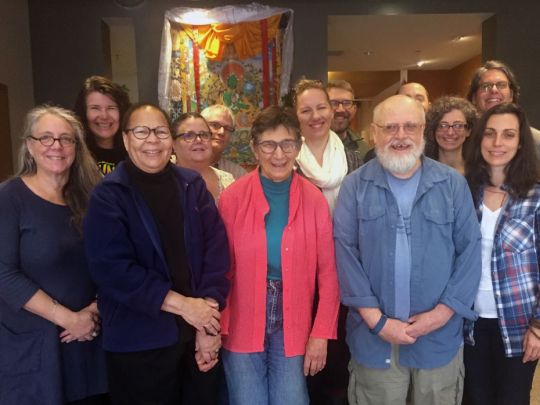
Dr. Jan Willis and students on the last day of the course, Maitripa College, Portland, OR, US, October 2017. Photo courtesy of Maitripa College.
Here are some suggestions for immediate actions that Professor Willis left the class with:
- Listen to progressive radio (PBS, NPR, BBC)
- Visit African-American sections in bookstores
- Go to ethnically-inspired museums
- Volunteer at homeless shelters, food pantries, kitchens
- Create or contribute to an online public resource center webpage
- Become an ally by understanding the other
- Learn about and follow #BlackLivesMatter and #SayHerName
Maitripa College remains committed to its mission of offering contemplative learning founded upon three pillars of scholarship, meditation, and service. The school serves our students, and the region, through diverse and relevant educational, religious, and community programs such as these.
Maitripa College plans to continue this series in the coming years with courses that focus on other aspects of bias in society such as class and gender. These arise from ignorance and illustrate how we create and perpetuate samsara in our world, and why we must free ourselves from ignorance. Please watch our website www.maitripa.org for details about these upcoming programs.
FPMT.org and Mandala Publications brings you news of Lama Zopa Rinpoche and of activities, teachings, and events from over 160 FPMT centers, projects, and services around the globe. If you like what you read, consider becoming a Friend of FPMT, which supports our work.
- Tagged: jan willis, maitripa college, namdrol miranda adams
28
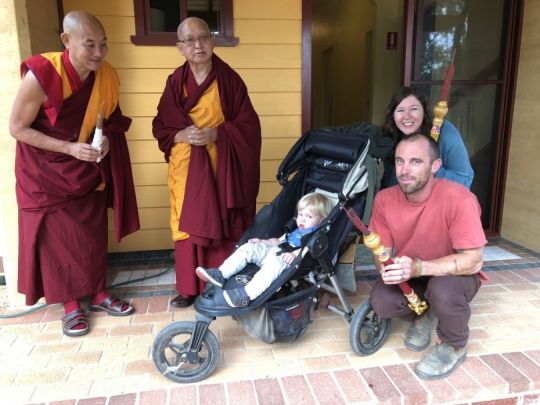
Geshe Thutben Rapten and Lama Zopa Rinpoche with Amy, Lozang, and Mila Hursthouse, Bendigo, Australia, May 2018. Photo by Ven. Roger Kunsang.
Thanks to Amy Hursthouse, spiritual program coordinator at FPMT center Chandrakirti Tibetan Buddhist Meditation Centre in New Zealand, and long-time student Lozang Hursthouse for interviewing retreat participants during the recent Bodhicaryavatara and Rinjung Gyatsa Retreat with Lama Zopa Rinpoche at The Great Stupa of Universal Compassion in Bendigo, Australia.
Students were asked two questions: What is the most personally meaningful thing you have learned at the retreat, that you will take home with you? What is your favorite memory from the retreat?
“The most meaningful thing I learned about was patience,” said one retreat participant. “My favorite memory was going for an impromptu walk in the Peace Park with Rinpoche and looking at all the statues. Lama Zopa Rinpoche told stories as we went around and gave teachings about the use of prayer wheels. He also gave directions for the future animals to go in the park. That was really interesting.”
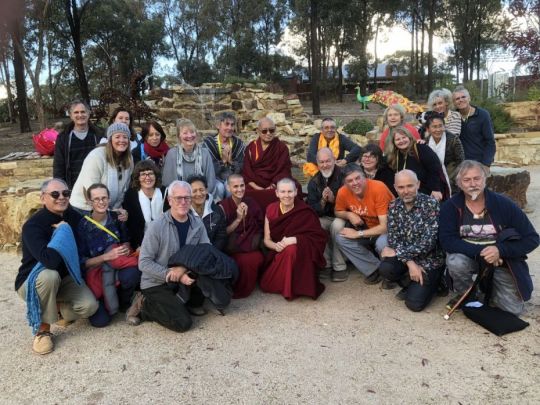
Lama Zopa Rinpoche with students in the Peace Park at The Great Stupa, Bendigo, Australia, May 2018. Photo by Ven. Roger Kunsang.
Another student said, “I learned everything has to be done with bodhichitta, all of your daily activities, and all those mundane things we do in the world. We just have to change our mind and do it with bodhichitta. Then it becomes a profound practice, and it transforms your whole life.
“My favorite memory is from one of the teachings. Rinpoche was sitting on his throne wildly waving his arms in the air as he super emphatically said, ‘It’s all a dream, it’s just a dream, you’re just dreaming. This is just a dream.’ It was really like palpable that we were actually dreaming. It made me realize it.”
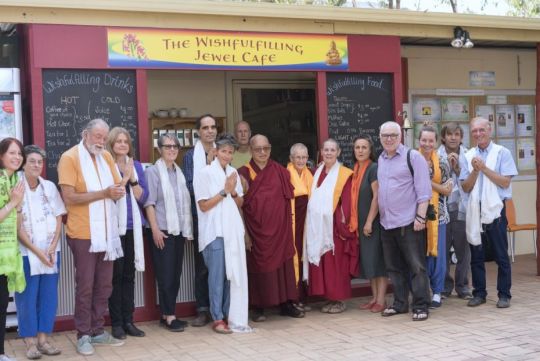
Lama Zopa Rinpoche with Atisha Centre staff and volunteers in front of the center cafe, Bendigo, Australia, April 2018. Photo by Ven. Lobsang Sherab.
Susan from Australia said, “The most meaningful part of the retreat for me was deepening the connection with Rinpoche as Buddha.”
“The most special part was being with Rinpoche. Listening to his teachings is so powerful,” Yen from Sydney said. “I also enjoyed translating and caring for students from overseas. I thought I’d come for retreat and be shut off from everyone, but actually I spent the whole time helping and serving others. I realized this is Rinpoche’s teaching. How to apply the teachings in daily life. I learned a lot from here. Serving sentient beings is so important.”
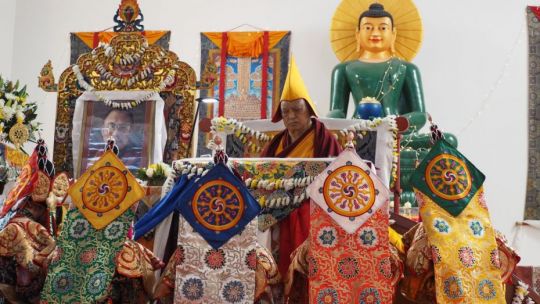
Long life puja for Lama Zopa Rinpoche, Bendigo, Australia, May 2018. Photo by Ven. Tenzin Tsultrim.
Several other students echoed the meaningfulness of doing a retreat with Rinpoche:
“Seeing Rinpoche and receiving such clear teachings, I understood better how to practice guru devotion. My favorite memory from the retreat is seeing Rinpoche. He is so amazing.”
“The most meaningful thing personally is that everything is in the mind. All of my experiences and what I believe to exist out there is all just like a movie, including the guru who is a manifestation of the dharmakaya. The guru who guides us appears through our karmic appearance, what we have the karma to see, just as Arya Asanga initially saw Maitreya as a wounded dog. We need to keep doing pure practice from the heart every day to prevent degeneration. My favorite memory is on the first night Rinpoche directly answered a question I had about how things exist. This bolstered my faith and I felt a lot of gratitude.”
“The most important thing I learned is the guru is the Buddha, and that by totally entrusting myself to him he will quickly lead me to enlightenment. The most meaningful part of the retreat was when Rinpoche give the initiation I had requested.”
“The most personally meaningful thing I have learned is that Rinpoche is my guru. My favorite memory is singing ‘Calling the Guru from Afar’ with Ven. Thubten Dechen.”
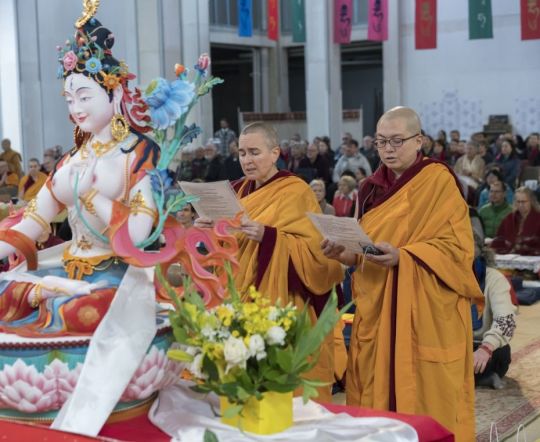
Ven. Gyalten Wangmo and Ven. Thubten Dechen offering the long life prayer composed by Khadro-la (Rangjung Neljorma Khandro Namsel Drönme) to Lama Zopa Rinpoche during the long life puja, The Great Stupa of Universal Compassion, Australia, May 2018. Photo by Ven. Lobsang Sherab.
“My favorite aspect of the retreat was the group practice sessions when Rinpoche was present, like Lama Chöpa,” Anne Marie from New Zealand said. “Ven. Thubten Dechen’s voice was a highlight. It made the prayers soar. The devotion rose through the sense of sound. It was such a blessing for me to be in the presence of Rinpoche and have the inspiration of the prayers. One thing I will remember for a long time was when Ven. Joan helped us to help clean the Stupa View relics room. It felt like such a privilege. We worked really hard, and it was one of those great moments.”
“Something I will remember for a long time was when we were chanting ‘Praises to the Twenty-One Taras’ while waiting for Rinpoche,” Vurgel from Germany said. “Suddenly, I heard Ven. Thubten Dechen start to sing so beautifully. We were lifted to Tara’s pure land. Rinpoche didn’t come so we kept singing and singing. It was like a pure realm.”
Aki from Singapore said, “This is my second time attending the retreat. The most meaningful part for me was spending so much time with Rinpoche. And everyone’s energy to make this retreat happen, all the good energy and harmony.”
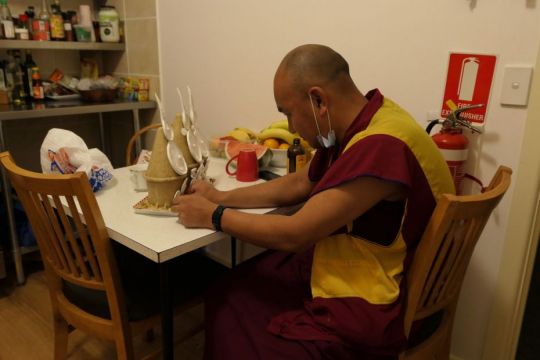
Ven. Thubten Tendar making tormas for the retreat, Bendigo, Australia, May 2018. Photo by Ven. Roger Kunsang.
Amy from Australia and New Zealand shared, “The most memorable moment of the retreat for me was the first time we saw Rinpoche with our son Mila. It deepened my faith greatly to see Rinpoche giving blessings to students, children, and animals, and then hearing the teachings on guru devotion, the importance of the guru.
“The long life puja was one of the most meaningful days. From Rinpoche’s profound teaching, to the number of people who came, and seeing how we were all so moved in our different ways throughout the prayers. Looking around it was powerful to see people from all around the world who have had their hearts and lives transformed through meeting the Dharma, studying, offering service, taking ordination, and dedicating their lives in so many different ways to others. The puja made manifest the incredible organization of FPMT, and all that it does and stands for. And the heart of it was Rinpoche guiding us all.”
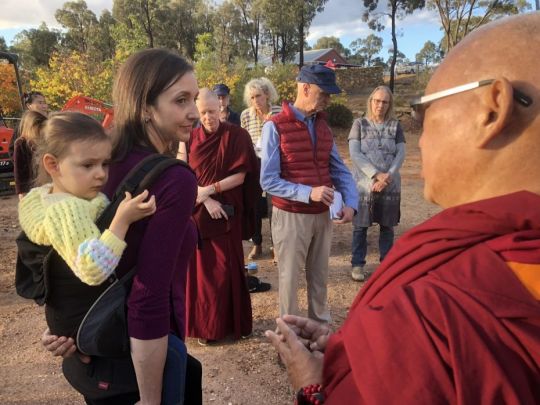
Lama Zopa Rinpoche blessing a child, Great Stupa of Universal Compassion, Bendigo, Australia, May 2018. Photo by Ven. Roger Kunsang.
Watch all of Lama Zopa Rinpoche’s teachings from the recent Bodhicaryavatara and Rinjung Gyatsa Retreat in Australia and find transcripts and translations of the teachings here:
https://fpmt.org/media/streaming/teachings-of-lama-zopa-rinpoche/lama-zopa-rinpoche-teachings-in-bendigo-2018/
FPMT.org and Mandala Publications brings you news of Lama Zopa Rinpoche and of activities, teachings, and events from over 160 FPMT centers, projects, and services around the globe. If you like what you read, consider becoming a Friend of FPMT, which supports our work.
- Tagged: amy hursthouse, australia retreat 2018, bendigo, great stupa of universal compassion, lozang hursthouse
23
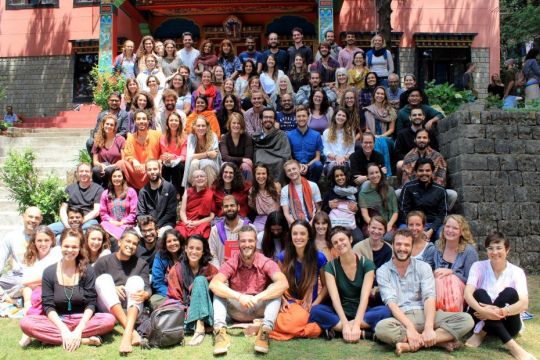
Introduction to Buddhism course with Ven. Tenzin Drolma and Maya at Tushita Meditation Centre, Dharamsala, India, May 2017. Photo courtesy of Paloma de Castro.
Acting director Archhana Kombrabail, spiritual coordinator Ven. Tenzin Kunphen, and the staff and volunteers at Tushita Meditation Centre in Dharamsala, India, shared this summary of 2017 accomplishments:
Without exaggeration, we can say that our 2017 season running from February to November was the most busy (and hopefully most beneficial) Tushita Meditation Centre has ever seen.
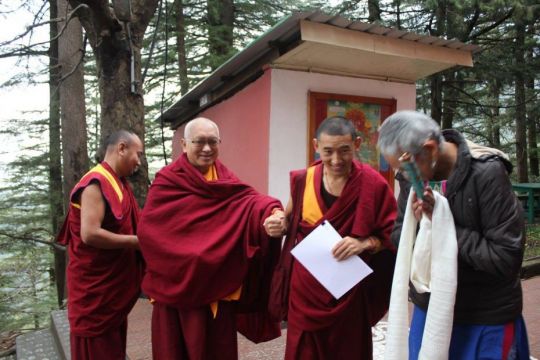
Lama Zopa Rinpoche on his way to meet with the Introduction to Buddhism course students at Tushita Meditation Centre with Ven. Thubten Tendar, Ven. Sangpo, and acting center director Archhana Kombrabail, Dharamsala, India, February 2017. Photo courtesy of Tushita Meditation Centre’s Facebook page.
Our 2017 season started with countless blessings by our precious guru Lama Zopa Rinpoche, who gave inspiring teachings, lungs, and advice during his seventeen-day stay before the Tibetan New Year.
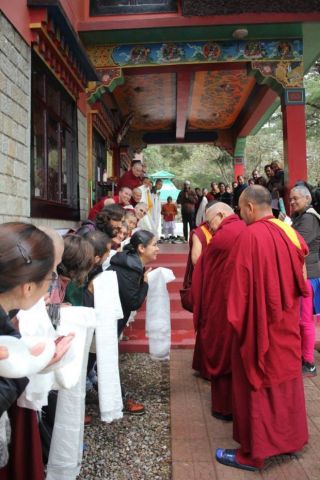
Lama Zopa Rinpoche with Introduction to Buddhism course students at Tushita Meditation Centre, Dharamsala, India, February 2017. Photo courtesy of Tushita Meditation Centre’s Facebook page.
After such an auspicious start we hosted with much energy and enthusiasm eighteen Introduction to Buddhism courses, four intermediate/advanced courses, and six group retreats. Highlights were the advanced courses with FPMT registered teachers Geshe Tenzin Namdak and Geshe Kelsang Wangmo, and courses and retreats with our resident teacher Ven. Tenzin Drolma.
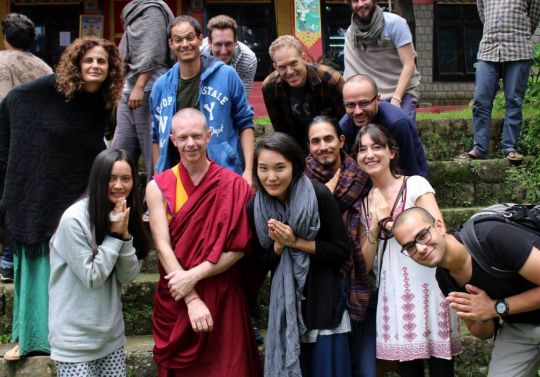
Geshe Tenzin Namdak and students at Tushita Meditation Centre, Dharamsala, India, July 2017. Photo courtesy of Paloma de Castro.
In addition, we were extremely fortunate to have Dagri Rinpoche teach a five-day course on Shantideva’s A Guide to Bodhisattva’s Way of Life with Dagri Rinpoche promising a continuation in the coming years. Another special six-day course was led by Geshe Lhakdor-la on Atisha’s Lamp of the Path to Enlightenment.
Brief statistics of our residential courses in 2017:
- 18 Introduction to Buddhism courses attended by a total of 1,734 students
- 1 special introduction course taught by Geshe Lhakdor-la and attended by 113 students
- 4 intermediate/advanced courses attended by a total of 136 students
- 6 group retreats attended by a total of 100 students
- 1 Pre-Ordination Course attended by 13 students
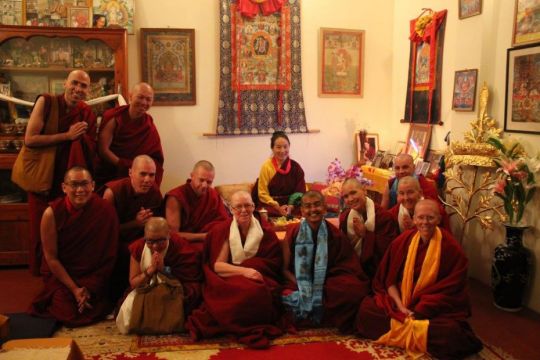
Pre-Ordination Course students with Khadro-la (Rangjung Neljorma Khandro Namsel Drönme) at Tushita Meditation Centre, Dharamsala, India, March 2017. Photo courtesy of Tushita Meditation Centre’s Facebook page.
This totals thirty residential courses and group retreats attended by 2,096 students. This is a new Tushita Meditation Centre record. Most of our courses again had long waiting lists, and once again our most numerous student nationality was India.
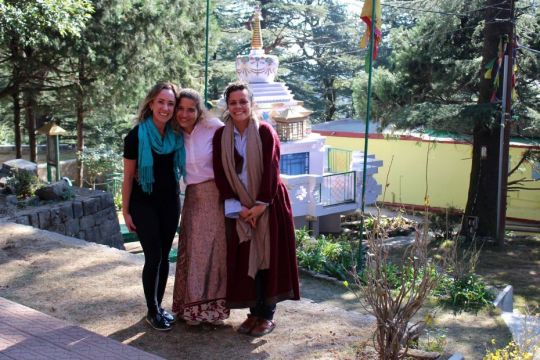
Introduction to Buddhism students in front of Lama Thubten Yeshe’s stupa, Dharamsala, India, November 2017. Photo courtesy of Tushita Meditation Centre’s Facebook page.
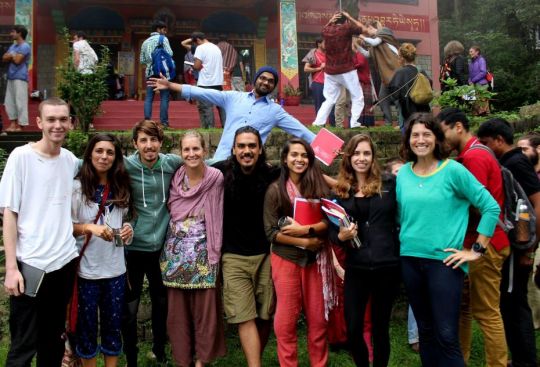
Introduction to Buddhism course by Ven. Tenzin Drolma and Renato at Tushita Meditation Centre, Dharamsala, India, August 2017. Photo courtesy of Paloma de Castro.
On top of all this, we hosted our very popular daily meditation sessions and other drop-in activities. These attracted thousands of visitors this season with visitors often squeezed tightly into our meditation halls and overflowing outside.
Absolute highlights of 2017 were His Eminence Ling Rinpoche’s two visits to give Rinpoche’s first official teaching at Tushita Meditation Centre on the Eight Verses of Mind Training and to convey Rinpoche’s first initiation at Tushita Meditation Centre of Long Life Amitayus. Both events were extremely popular, and we pray that many more will follow.
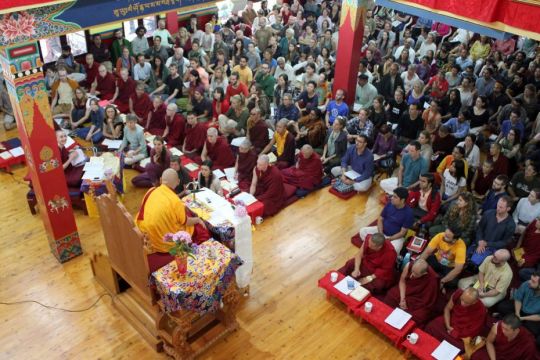
His Eminence Ling Rinpoche at Tushita Meditation Centre, Dharamsala, India, June 2017. Photo courtesy of Tushita Meditation Centre’s Facebook page.

His Eminence Ling Rinpoche arriving at Tushita Meditation Centre, Dharamsala, India, August 2017. Photo courtesy of Tushita Meditation Centre’s Facebook page.
Further highlights were teachings and initiation by Yangten Rinpoche, Tsenshap Serkong Rinpoche, Khadro-la (Rangjung Neljorma Khandro Namsel Drönme), Jetsunma Tenzin Palmo, and Gen Gyatso-la.
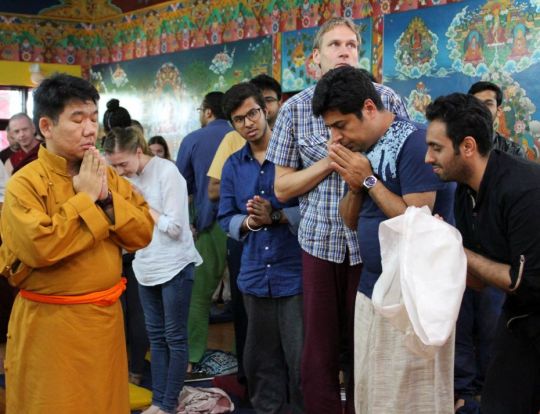
Tsenshap Serkong Rinpoche entering the gompa at Tushita Meditation Centre, Dharamsala, India, June 2017. Photo courtesy of Paloma de Castro.
On behalf of all of the staff and students of Tushita Meditation Centre, we most humbly offer any merits that have been accumulated through these and all other Tushita Meditation Centre activities to Lama Zopa Rinpoche’s perfect health, inconceivable long life, and the immediate, perfect fulfillment of every one of his holy wishes, particularly that the Maitreya statue projects will be completed swiftly and perfectly for the benefit of all sentient beings.

Sangha approaching Lama Zopa Rinpoche with the tsog offering during Guru Puja, February 2017. Photo courtesy of Tushita Meditation Centre’s Facebook page.
We also pray that these merits will ripen so that Tushita Meditation Centre will always flourish as a place of harmony helping to spread the Dharma exactly as Lama Zopa Rinpoche wishes. With minds going out with great compassion in whatever direction the most precious teachings have not yet spread, or once spread have now declined, may those who serve and study at Tushita Meditation Centre always uphold the Buddha’s teachings, and with every act of body, speech, and mind, may we always reveal this treasure of happiness and aid.
For information about Tushita Meditation Centre in Dharamsala, India visit their website:
http://tushita.info
FPMT.org and Mandala Publications brings you news of Lama Zopa Rinpoche and of activities, teachings, and events from over 160 FPMT centers, projects, and services around the globe. If you like what you read, consider becoming a Friend of FPMT, which supports our work.
- Tagged: dharamsala, geshe tenzin namdak, khandro kunga bhuma, kyabje ling rinpoche, lama zopa rinpoche, serkong tsenshab rinpoche, tushita meditation centre, ven. tenzin kunphen
16
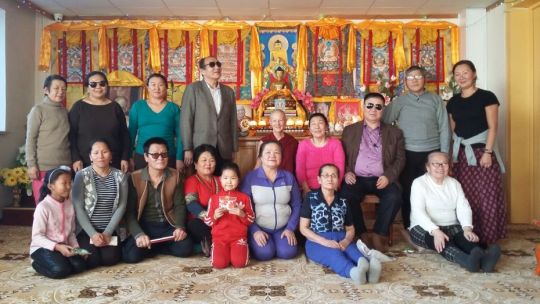
Short course participants from the Mongolian Blind People’s Association with teacher Ven. Thubten Gyalmo and interpreter Khulan Dembereldorj, Ulaanbaatar, Mongolia, February 2018. Photo by Ianzhina Bartanova.
FPMT center Ganden Do Ngag Shedrup Ling and the Mongolian Blind People’s Association have come together to benefit the visually impaired community in Ulaanbaatar, Mongolia. Ganden Do Ngag Shedrup Ling’s resident teacher Ven. Thubten Gyalmo and center director Ianzhina Bartanova share their reflections on the collaboration:
Ganden Do Ngag Shedrup Ling is delighted to share that in January and February we successfully offered a five-week meditation and relaxation course for fifteen people from the Mongolian Blind People’s Association.
Approximately sixteen thousand Mongolians experience blindness. Of this number, two thousand are living in Mongolia’s capital city, Ulaanbaatar. Ninety percent of visually impaired Mongolians do not have an income, apart from a small monthly pension of 140,000 MNT (US$58) received from the government. Employment opportunities are extremely limited. Some visually impaired community members receive massage training so that they can provide massage services in various salons.
In October 2017 we met with the Mongolian Blind People’s Association after they inquired about support for families with many children. At that time, we were able to distribute some clothing, blessing strings, and vitamins.
We learned the Mongolian Blind People’s Association consists of approximately three thousand people, with seven hundred of these being quite active members. We began to discuss opportunities for future collaboration, and tried to identify ways that Ganden Do Ngag Shedrup Ling could benefit the organization’s community.
The social worker at the Mongolian Blind People’s Association met with us and shared how difficult things can be for visually impaired community members in Ulaanbaatar. They can be reluctant to leave their apartments due to the fear of danger. Ulaanbaatar has many unpaved footpaths that are difficult to navigate, and it is dangerous to cross the street because drivers can be unpredictable and not mindful of pedestrians.
Ven. Thubten Gyalmo was very supportive of the idea of offering a breathing, relaxation, and meditation course to visually impared community members associated with the Mongolian Blind People’s Association. The goal for the course was to reduce stress and bring about more inner contentment.
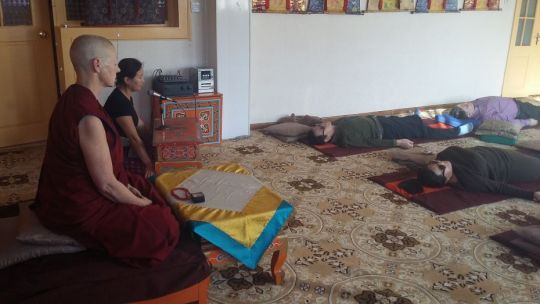
Short course participants from the Mongolian Blind People’s Association with teacher Ven. Thubten Gyalmo and interpreter Khulan Dembereldorj, Ulaanbaatar, Mongolia, February 2018. Photo by Ianzhina Bartanova.
To make it easier for people to attend the course, we decided to hold the course at the head office of the Mongolian Blind People’s Association on the outskirts of Ulaanbaatar. Ven. Thubten Gyalmo and interpreter Khulan Dembereldorj, who also serves as Ganden Do Ngag Shedrup Ling’s spiritual program coordinator, traveled there to lead the course.
We planned to meet at the head office for the entire course. However, our collaboration was so successful that by the third class, all fifteen course participants made their way to Ganden Do Ngag Shedrup Ling in the city center, having managed to find taxis for all.
Some course participants were accompanied by their children and spouses. We could see how much the group was enjoying the outing and were delighted when some of the participants commented on the special environment of Ganden Do Ngag Shedrup Ling. At the conclusion of the third class everyone appeared relaxed and so pleased to have made the effort to come to Ganden Do Ngag Shedrup Ling.
The wonderful outcome was that the group continued to make their way to Ganden Do Ngag Shedrup Ling for the remaining two classes of the five-week meditation and relaxation course.
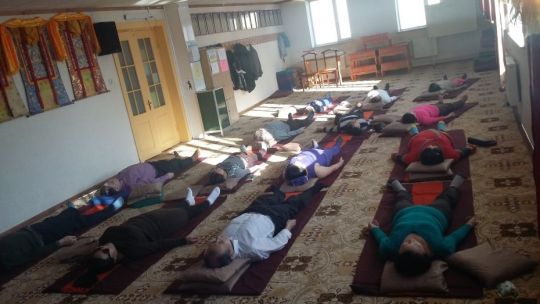
Short course participants from the Mongolian Blind People’s Association, Ulaanbaatar, Mongolia, February 2018. Photo by Ianzhina Bartanova.
At the end of the course we offered a few copies of Lama Zopa Rinpoche’s book Ultimate Healing to the organization. The Mongolian Blind People’s Association coordinator, Degi promised that the book will be read aloud during their future meetings.
We are now arranging for audio recordings of Ultimate Healing in Mongolian, so we can then offer these to the Mongolian Blind People’s Association. We agreed to continue our cooperation with the Mongolian Blind People’s Association at the earliest convenience.
For more information about Ganden Do Ngag Shedrup Ling visit their website:
http://www.fpmtmongolia.org/shedrub-ling-center/
FPMT.org and Mandala Publications brings you news of Lama Zopa Rinpoche and of activities, teachings, and events from over 160 FPMT centers, projects, and services around the globe. If you like what you read, consider becoming a Friend of FPMT, which supports our work.
- Tagged: fpmt mongolia, ganden do ngag shedrup ling, ianzhina bartanova, mongolia, mongolian blind people's association, ven. thubten gyalmo
9
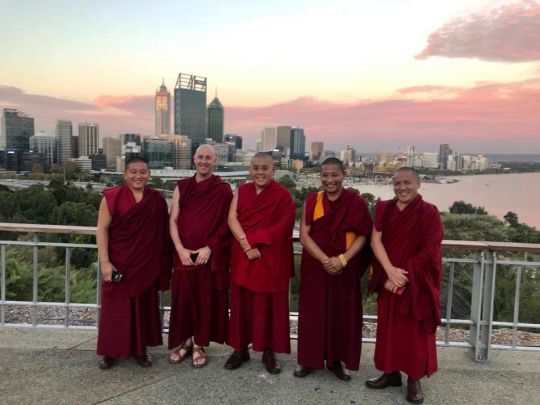
Geshe Lobsang Yonten, Ven. Kartsön (Yaki Platt), H.E. Ling Rinpoche, Geshe Ngawang Sonam, and Ven. Tenzin Khentse in King’s Park, overlooking the city of Perth and the Swan River, Perth, Western Australia, March 2018. Photo courtesy of Kirsti Kilbane.
His Eminence Ling Rinpoche traveled to Perth, Western Australia, in March upon the invitation of FPMT center Hayagriva Buddhist Centre, spending one week in the coastal city. Ros Charron, newsletter editor at Hayagriva Buddhist Centre, shares the details of his visit:
His Eminence Ling Rinpoche arrived in Perth, Western Australia, on Tuesday, March 21, 2018. Upon arriving at Perth Airport Rinpoche was warmly greeted by Hayagriva Buddhist Centre resident teacher Geshe Ngawang Sonam, center director John Waite, and students.
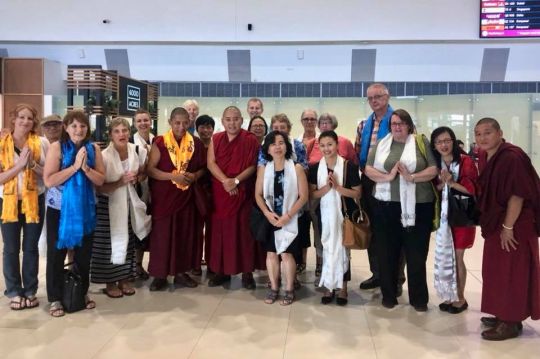
Geshe Ngawang Sonam, H.E. Ling Rinpoche, Geshe Lobsang Yonten, center director, and students at Perth Airport, Perth, Western Australia, March 2018. Photo courtesy of Ven. Tenzin Khentse.
We were so thrilled to have Rinpoche come to Perth. His planned activities included a public talk, “The Buddhist Science of Happiness,” at the University of Western Australia, as well as a two-day teaching on Lama Tsongkhapa’s prayer The Foundation of All Good Qualities and a Je Rig Sum Chig Thus jenang at the Metro Hotel Perth.
We were all touched by Rinpoche’s warmth, his gentle and easy going manner, and how amazingly generous he was with his time during his week-long stay here.
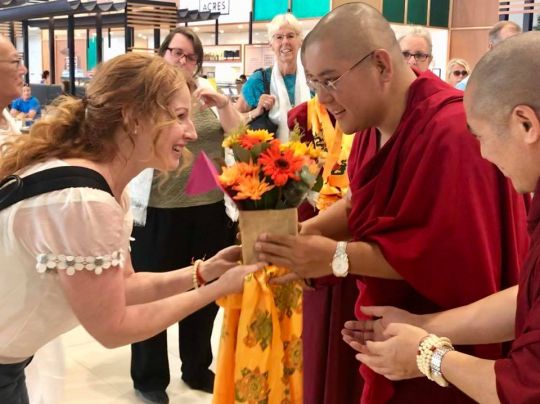
H.E. Ling Rinpoche greeted at Perth Airport by Kirsti Kilbane, Perth, Western Australia, March 2018. Photo courtesy of Jude Milan.
In the course of the week H.E. Ling Rinpoche attended a lunch with members of Hayagriva Buddhist Centre. The lunch was hosted by Vietnamese restaurant owner and generous Hayagriva Buddhist Centre benefactor Sony Tang. Afterwards Rinpoche went for a boat ride on the picturesque Swan River.
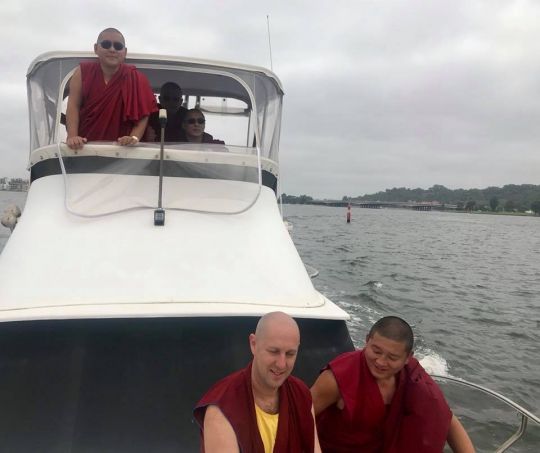
H.E. Ling Rinpoche, Ven. Tenzin Khentse, Geshe Lobsang Yonten, Ven. Kartsön (Yaki Platt), and John Waite enjoying a boat ride on Swan River, Perth, Western Australia, March 2018. Photo courtesy of Kirsti Kilbane.
On Thursday, March 22, H.E. Ling Rinpoche visited Hayagriva Buddhist Centre. We are so grateful for the statue Rinpoche donated to the center that day. This exquisite Lama Tsongkhapa statue is filled with many rare and difficult to obtain holy objects, including pieces of robes that belonged to His Holiness the Sixth Yongzin Ling Rinpoche, who passed away in 1983.
The following day H.E. Ling Rinpoche visited the University of Western Australia’s campus, where he gave a public talk on “The Buddhist Science of Happiness” at the Octagon Theatre. More than two hundred people came to hear Rinpoche speak at this event on campus.
H.E. Ling Rinpoche then spent the weekend teaching on Lama Tsongkhapa’s prayer The Foundation of All Good Qualities at the Metro Hotel Perth.
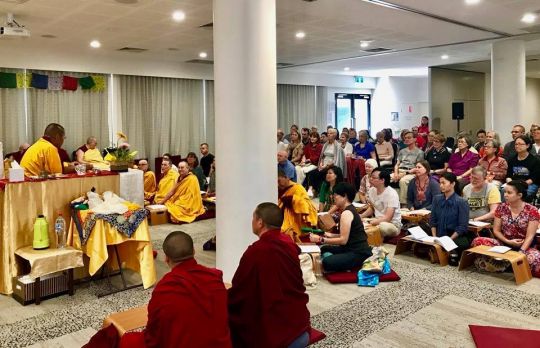
H.E. Ling Rinpoche teaching at the Metro Hotel Perth, Perth, Western Australia, March 2018. Photo courtesy of Kirsti Kilbane.
On the second day of the two-day teaching Rinpoche conferred the Je Rig Sum Chig Thus jenang.
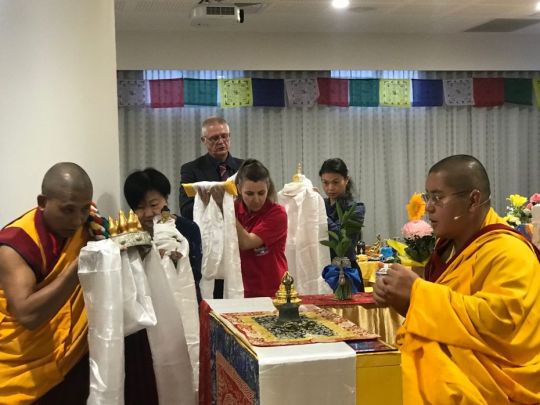
Geshe Ngawang Sonam, Oi Loon Lee, Jude Milan, Nora Daniels, and John Waite making a mandala offering to H.E. Ling Rinpoche at the Metro Hotel Perth, Perth, Western Australia, March 2018. Photo courtesy of Kirsti Kilbane.
Rinpoche visited the Hayagriva Buddhist Centre the following day, blessing us with his presence as we engaged in the practice of Guru Puja also known as Lama Chöpa.
During his time with us H.E. Ling Rinpoche liberated Western Australian rock lobster, a species native to the Western Australian coast, purchased by Hayagriva Buddhist Centre from a local fish market.
The Government of Western Australia, Department of Primary Industries and Regional Development confirmed it was suitable to release them onto the reef at Cottesloe Beach in Perth. Rinpoche was assisted by students, who carried the Western Australian rock lobster from the shoreline into the Indian Ocean.
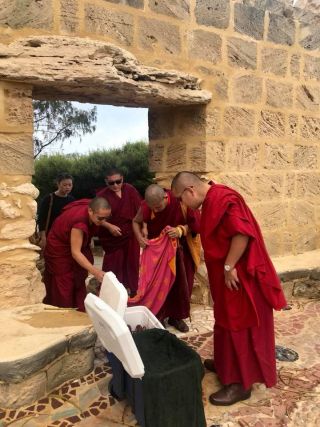
H.E. Ling Rinpoche with Ven. Tenzin Khentse, Geshe Lobsang Yonten, Geshe Ngawang Sonam, and Nora Daniels liberating Western Australian rock lobster, Perth, Western Australia, March 2018. Photo courtesy of Kirsti Kilbane.
Rinpoche also paid a visit to AQWA, the Aquarium of Western Australia.

H.E. Ling Rinpoche, Geshe Lobsang Yonten, and John Waite at the Aquarium of Western Australia, Perth, Western Australia, March 2018. Photo courtesy of Ven. Kartsön (Yaki Platt).
H.E. Ling Rinpoche visited Hayagriva Buddhist Center one final time before departing Australia from Perth Airport. Rinpoche gave a short talk to volunteers and organizers who assisted with his visit to Perth.
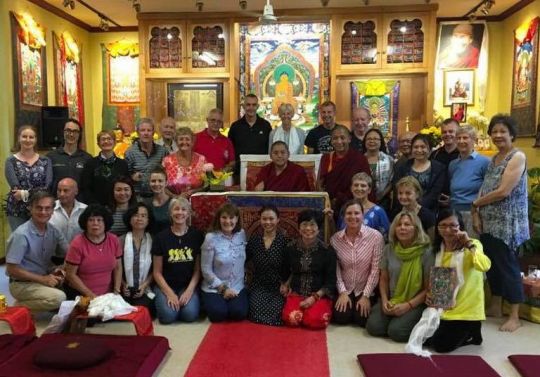
H.E. Ling Rinpoche with volunteers and organizers at Hayagriva Buddhist Center, Perth, Western Australia, March 2018. Photo courtesy of Ven. Tenzin Khentse.
We pray for H.E. Ling Rinpoche’s very long life and perfect health, and for all of Rinpoche’s holy wishes and precious Dharma activities to be accomplished instantly and without any obstacles in order to bring great benefit to all sentient beings. We hope and pray that Rinpoche will return to Perth to teach and bless us again very soon!
For more information about Hayagriva Buddhist Centre visit their website:
http://hayagriva.org.au
For the latest news about H.E. Ling Rinpoche’s schedule visit Rinpoche’s website:
http://lingrinpoche.info/schedule.php
FPMT.org and Mandala Publications brings you news of Lama Zopa Rinpoche and of activities, teachings, and events from over 160 FPMT centers, projects, and services around the globe. If you like what you read, consider becoming a Friend of FPMT, which supports our work.
2
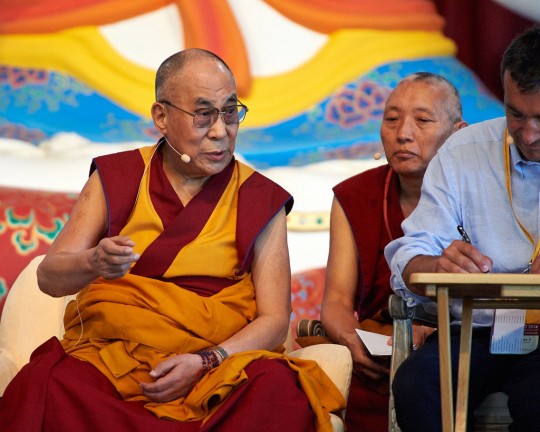
His Holiness the Dalai Lama teaching at Istituto Lama Tzong Khapa with Geshe Tashi Tsering, resident geshe at Jamyang Buddhist Centre, and Fabrizio Palliotti, providing interpretation, Pomaia, Italy, June 13, 2014. Photo by Olivier Adam.
His Holiness the Dalai Lama has appointed Geshe Tashi Tsering abbot of Sera Mey Monastery in Bylakuppe, South India. A long-time FPMT resident teacher, Geshe Tashi Tsering will be relocating from the UK to India, returning to the monastery where he began his monastic education.
Born in Purang, Tibet, in 1958, Geshe Tashi Tsering and his parents fled to India one year later. He entered Sera Mey Monastery in Bylakuppe, South India, at the age of thirteen. After receiving his Geshe Lharamapa degree from Sera Mey Monastery in 1987, he studied at Gyuto Tantric College for another year.
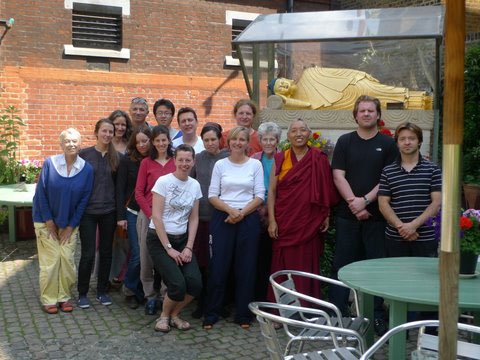
Medicine Buddha Retreat with Geshe Tashi Tsering, UK, 2017. Photo courtesy of Jamyang Buddhist Centre’s Facebook page.
Geshe Tashi Tsering has been teaching at FPMT centers for more than twenty-five years. In 1994, after teaching at Nalanda Monastery in France for several years, Geshe Tashi Tsering became the resident teacher at FPMT center Jamyang Buddhist Centre in London, England.
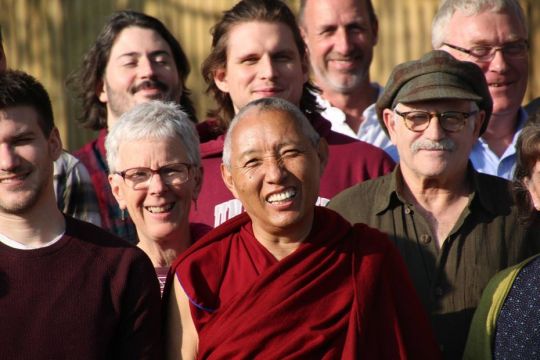
Geshe Tashi Tsering with students, UK. Photo courtesy of Jamyang Buddhist Center Leeds’ Facebook page.
In addition to teaching in London, Geshe Tashi Tsering travels to teach at other FPMT centers and study groups in the UK.
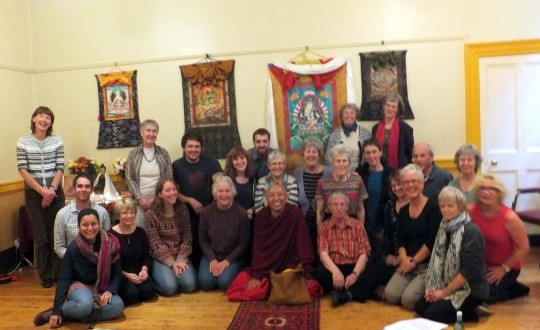
Geshe Tashi Tsering teaches on buddha nature to the students of Jamyang Bath Study Group, UK, October 2014. Photo courtesy of Sandra Whilding.
His willingess to travel to Leeds, UK, to teach enabled FPMT center Jamyang Leeds to establish itself twenty-one years ago.

Retreat with Geshe Tashi Tsering, UK, 2011. Photo courtesy of Jamyang Centre Leeds’ Facebook page.
Geshe Tashi Tsering has created The Foundation of Buddhist Thought, a two-year, six-module correspondence course. He is the author of a six-volume series by the same name, published by Wisdom Publications.
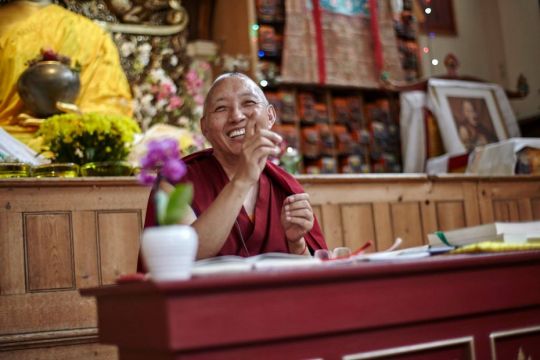
Geshe Tashi Tsering teaching at Jamyang Buddhist Center, UK. Photo courtesy of Jamyang Buddhist Centre’s Facebook page.
To learn more about FPMT’s study programs visit:
https://fpmt.org/education/programs/
FPMT.org brings you news of Lama Zopa Rinpoche and of activities, teachings and events from over 160 FPMT centers, projects and services around the globe. If you like what you read, consider becoming a Friend of FPMT, which supports our work.
- Tagged: geshe tashi tsering, jamyang bath, jamyang buddhist centre, jamyang buddhist centre leeds, sera mey monastery
25
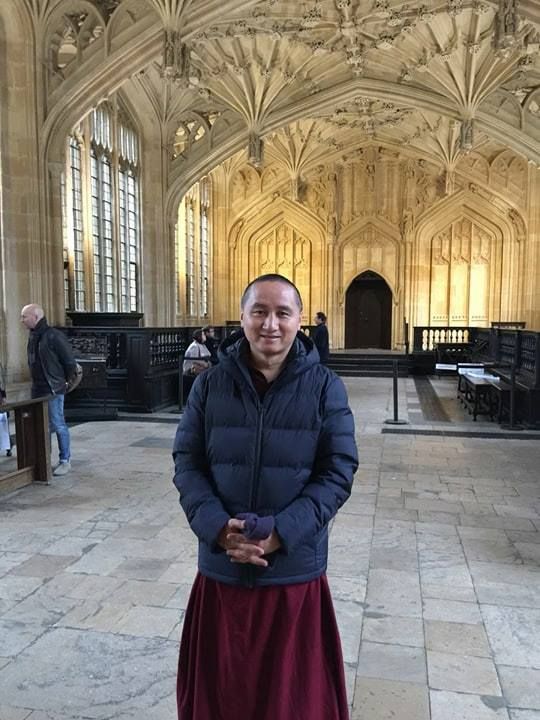
Geshe Tenzin Zopa at Oxford University, Oxford, UK, January 2018. Photo courtesy of FPMT Australia’s Facebook page.
FPMT touring teacher Geshe Tenzin Zopa recently completed an eight-week So-Wide Visitorship for Traditional Scholars in the Tibetan and Himalayan Studies program, part of the Faculty of Oriental Studies at Oxford University in the UK.
A small group of master’s and doctoral students in the Tibetan and Himalayan Studies program are learning the Tibetan language so that they can work with Tibetan texts. Geshe Tenzin Zopa met with a group of students once per week for eight weeks, guiding them through the reading of a Tibetan text. He was also busy giving public talks, meeting with students to discuss their projects, and leading meditations. The students also had the opportunity to watch the film Unmistaken Child.
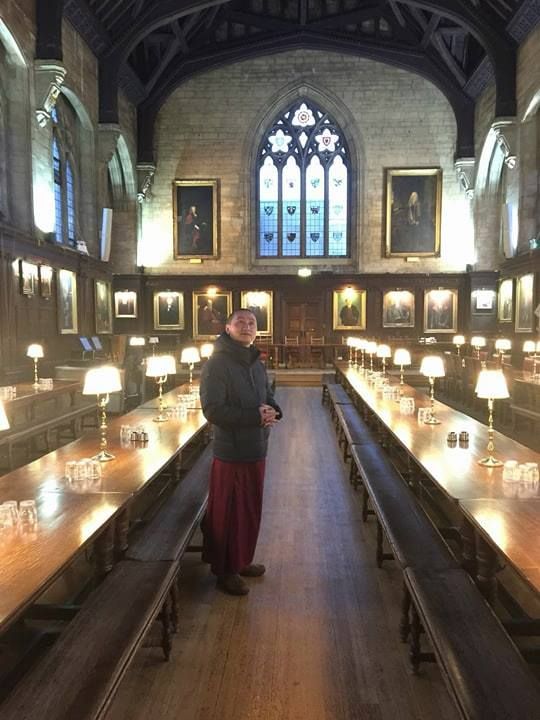
Geshe Tenzin Zopa at Oxford University, Oxford, UK, January 2018. Photo courtesy of FPMT Australia’s Facebook page.
Geshe Tenzin Zopa spent some time getting to know the Oxford faculty and their teaching styles through attending lectures.
The Visitorship was offered to Geshe Tenzin Zopa by the nonprofit So-Wide (The Society for the Wider Understanding of the Buddhist Tradition) in association with the Oxford Centre for Buddhist Studies and the Faculty of Oriental Studies at Oxford University.
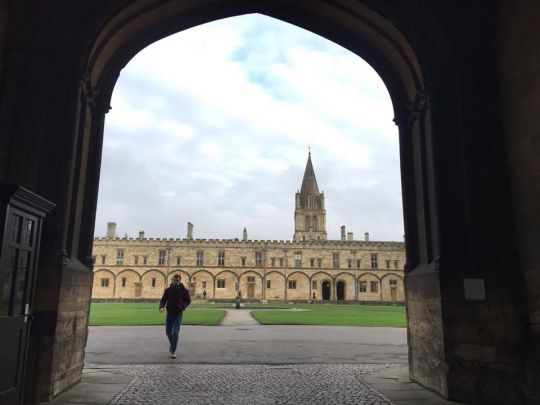
Oxford University campus, Oxford, UK, January 2018. Photo courtesy of Geshe Tenzin Zopa’s Facebook page.
While at Oxford, Geshe Tenzin Zopa resided at the Oxford Buddha Vihara, but traveled the UK to give talks at FPMT centers.
In March, Geshe Graham Woodhouse and former Jamyang center director Marcos Troia traveled to Oxford for Geshe Tenzin Zopa’s farewell event. They attended a talk he gave to thirty people about the traditional monastic system and Sera Je Monastery. Geshe Graham Woodhouse contributed his experience as a Westerner in India. Geoff Bamford, who organized the Visitorship for Geshe Tenzin Zopa on behalf of the Oxford Centre for Buddhist Studies and So-Wide, also spoke at the event.
Reflecting on his experience at Oxford, Geshe Tenzin Zopa had this to share:
“Om Ah Hum! … After learning a bit of history about how this place has developed as a great learning institution, it reminds me in many ways of, and makes me feel a deep appreciation for, the great ancient Nalanda University in ancient India, as well as the Tibetan monastic universities like Sera.
“It made me feel so proud of myself and those who have had the privilege of studying in great monastic universities like Sera, Drepung, and Ganden. We are so extremely fortunate to have such extraordinary learning institutions within the Tibetan Buddhist tradition. Rejoice, rejoice, we must rejoice.”
Geshe Tenzin Zopa is now attending Lama Zopa Rinpoche’s Bodhicaryavatara and Rinjung Gyatsa Retreat at The Great Stupa of Universal Compassion in Bendigo, Australia.

Geshe Tenzin Zopa with Lama Zopa Rinpoche, Bendigo, Australia, April 2018. Photo by Ven. Roger Kunsang.
Watch Lama Zopa Rinpoche teach during the Bodhicaryavatara and Rinjung Gyatsa Retreat at The Great Stupa of Universal Compassion in Bendigo, Australia, March 30-May 12, 2018.
- Find links to watch teachings LIVE:
https://fpmt.org/media/streaming/lama-zopa-rinpoche-live/ - Watch, read, and listen to all of Rinpoche’s teachings from Bendigo at anytime:
https://fpmt.org/media/streaming/teachings-of-lama- zopa-rinpoche/
FPMT.org brings you news of Lama Zopa Rinpoche and of activities, teachings and events from over 160 FPMT centers, projects and services around the globe. If you like what you read, consider becoming a Friend of FPMT, which supports our work.
- Tagged: Geshe Tenzin Zopa, oxford university
- Home
- News/Media
- Study & Practice
- About FPMT Education Services
- Latest News
- Programs
- New to Buddhism?
- Buddhist Mind Science: Activating Your Potential
- Heart Advice for Death and Dying
- Discovering Buddhism
- Living in the Path
- Exploring Buddhism
- FPMT Basic Program
- FPMT Masters Program
- FPMT In-Depth Meditation Training
- Maitripa College
- Lotsawa Rinchen Zangpo Translator Program
- Universal Education for Compassion & Wisdom
- Online Learning Center
- Prayers & Practice Materials
- Overview of Prayers & Practices
- Full Catalogue of Prayers & Practice Materials
- Explore Popular Topics
- Benefiting Animals
- Chenrezig Resources
- Death & Dying Resources
- Lama Chopa (Guru Puja)
- Lama Zopa Rinpoche: Compendium of Precious Instructions
- Lama Zopa Rinpoche: Life Practice Advice
- Lama Zopa Rinpoche Practice Series
- Lamrim Resources
- Mantras
- Prayer Book Updates
- Purification Practices
- Sutras
- Thought Transformation (Lojong)
- Audio Materials
- Dharma Dates – Tibetan Calendar
- Translation Services
- Publishing Services
- Teachings and Advice
- Find Teachings and Advice
- Lama Zopa Rinpoche Advice Page
- Lama Zopa Rinpoche: Compendium of Precious Instructions
- Lama Zopa Rinpoche Video Teachings
- ༧སྐྱབས་རྗེ་བཟོད་པ་རིན་པོ་ཆེ་མཆོག་ནས་སྩལ་བའི་བཀའ་སློབ་བརྙན་འཕྲིན།
- Podcasts
- Lama Yeshe Wisdom Archive
- Buddhism FAQ
- Dharma for Young People
- Resources on Holy Objects
- Ways to Offer Support
- Centers
- Affiliates Area
- Teachers
- Projects
- Charitable Projects
- Make a Donation
- Applying for Grants
- News about Projects
- Other Projects within FPMT
- Support International Office
- Projects Photo Galleries
- Give Where Most Needed
- FPMT
- Shop
Subscribe to FPMT News
Translate*
*powered by Google TranslateTranslation of pages on fpmt.org is performed by Google Translate, a third party service which FPMT has no control over. The service provides automated computer translations that are only an approximation of the websites' original content. The translations should not be considered exact and only used as a rough guide.My approach is to expose your ego so that you can see it for what it is. Therefore, I try to provoke your ego. There’s nothing diplomatic about this tactic. We’ve been diplomatic for countless lives, always trying to avoid confrontation, never meeting our problems face to face. That’s not my style. I like to meet problems head on and that’s what I want you to do, too.







